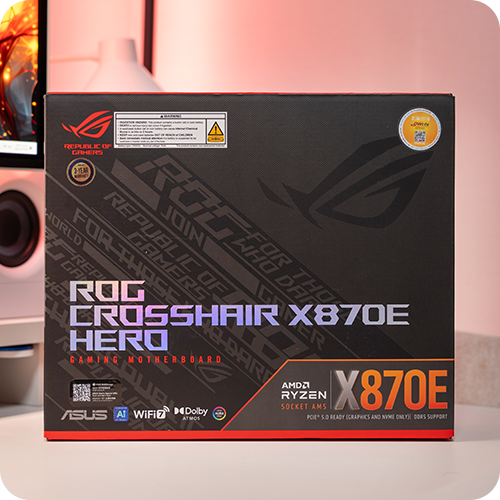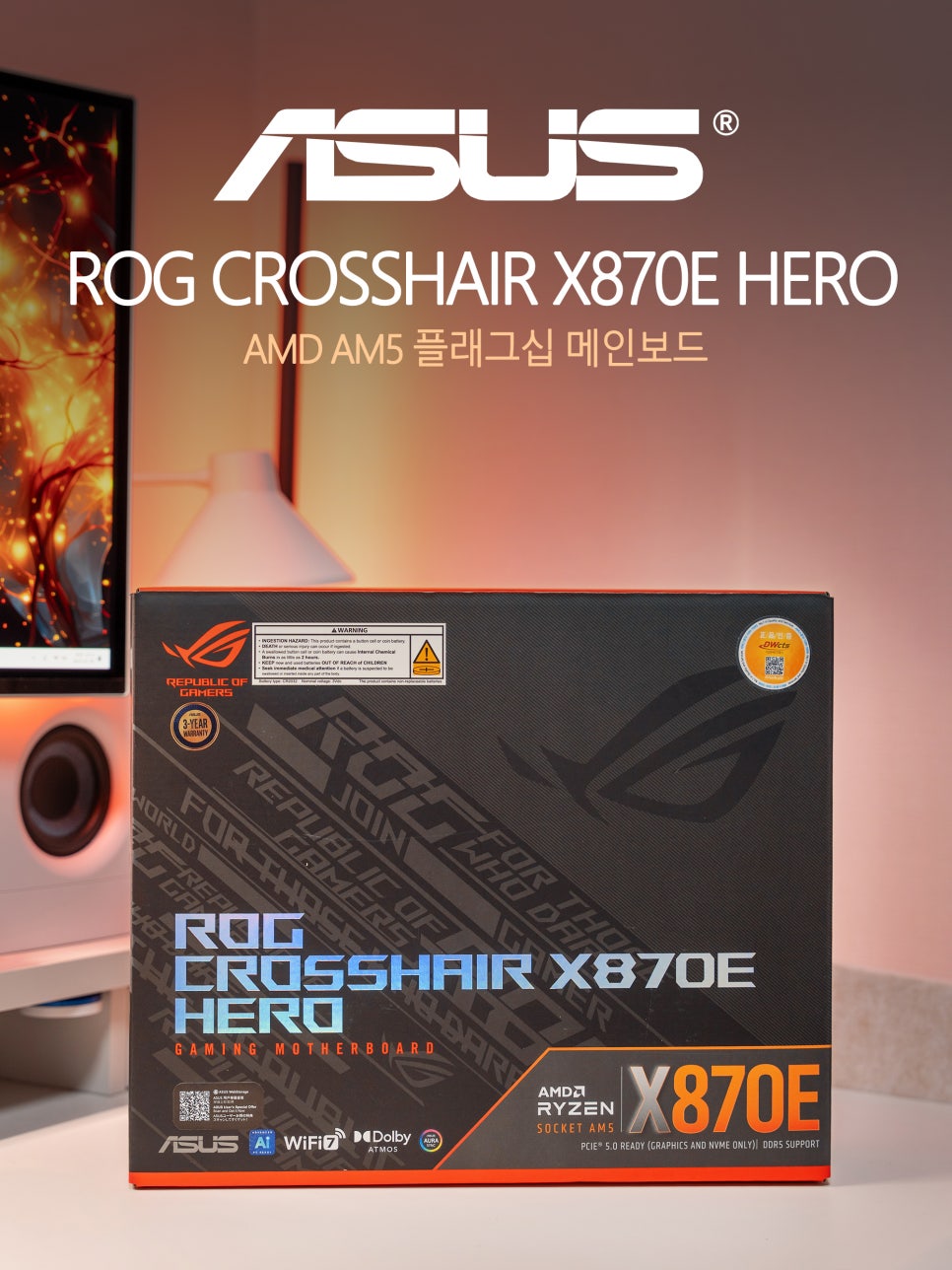
The AMD 9000 series, based on the Zen 5 architecture, offers improved IPC and power efficiency compared to previous generations. Notably, the AMD Ryzen 7 9800X3D is a flagship processor that delivers excellent performance in gaming environments through its 3D V-Cache technology.
When selecting a motherboard for the 9800X3D, the most crucial factors are stable power supply, support for high-clock memory, and next-generation expandability. To utilize high-clock memory above DDR5-8000MHz, PCIe 5.0 SSDs, and the latest graphics cards, a flagship motherboard based on the X870E chipset is essential.
In the AM5 platform chipset lineup, the X870E chipset offers expanded PCIe 5.0 lane support and more high-speed I/O compared to the X870. While the X870 meets basic requirements, the X870E provides the best features and performance for building a flagship gaming system with USB4 40Gbps support, additional PCIe 5.0 lanes, and built-in Wi-Fi 7.
Today, we will take a look at the ASUS ROG CROSSHAIR X870E HERO from Daewon CTS.
Specifications and Configuration
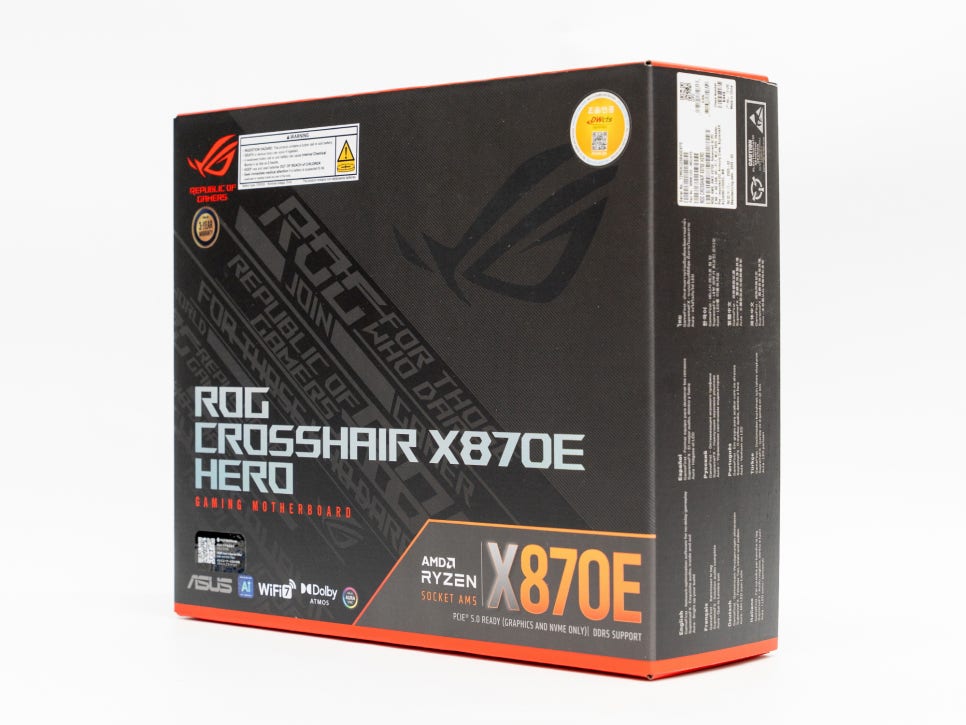
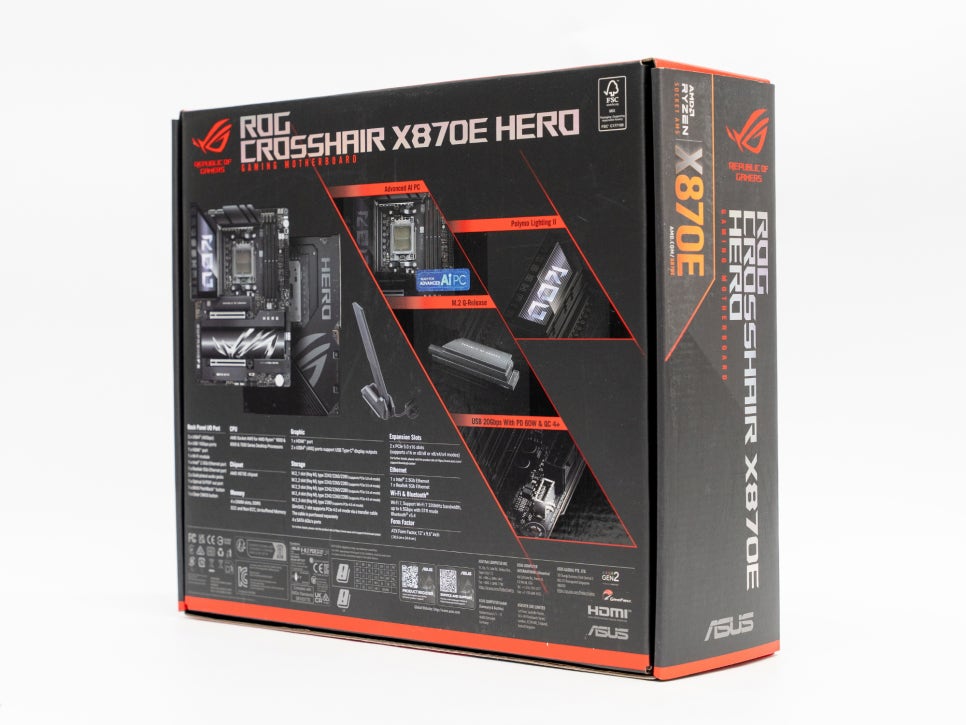
The ASUS ROG CROSSHAIR X870E HERO is a flagship ATX form factor motherboard that supports both Ryzen 7000 and 9000 series through the AMD Socket AM5. Based on the AMD X870E chipset, it can support up to 192GB of DDR5-8600+(OC) memory. A notable feature is its robust power supply system configured with 18+2+2 phases, ensuring stable power delivery through 18 110A SPS MOSFETs.
The X870E chipset, AMD’s latest flagship chipset, boasts significantly improved performance over previous generations. The most significant change is the provision of a total of 24 PCIe 5.0 lanes, which is three times more than the X670E. It also offers native USB4 support with standard 40Gbps USB4 ports and integrated Wi-Fi 7 for fast and stable connections with the latest wireless standards. The enhanced I/O bandwidth allows for optimized performance without degradation when using high-speed storage and various peripherals simultaneously.
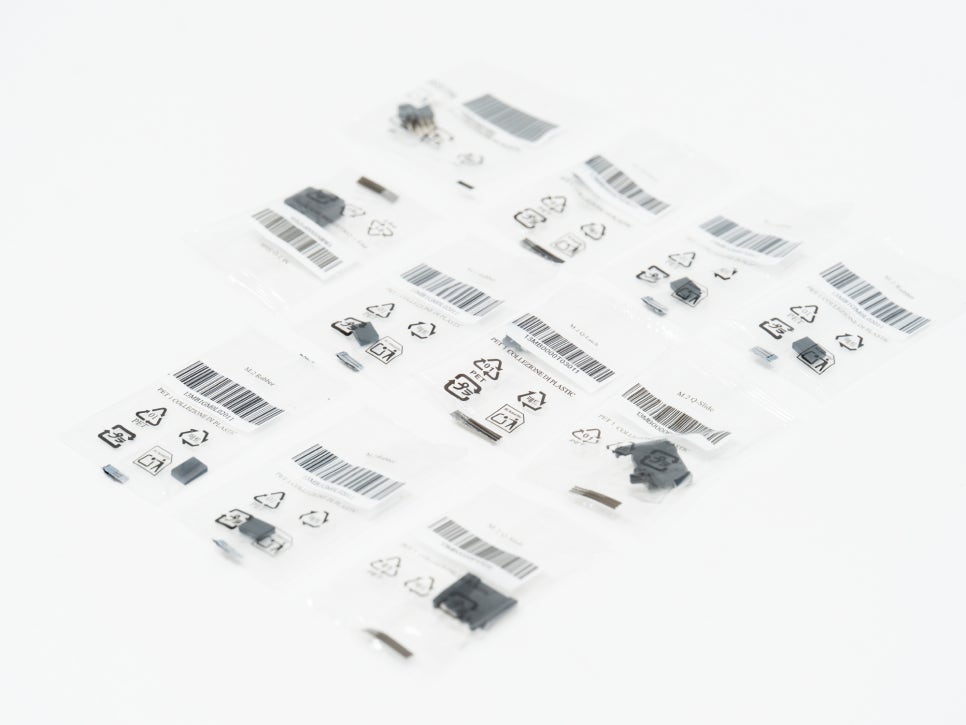
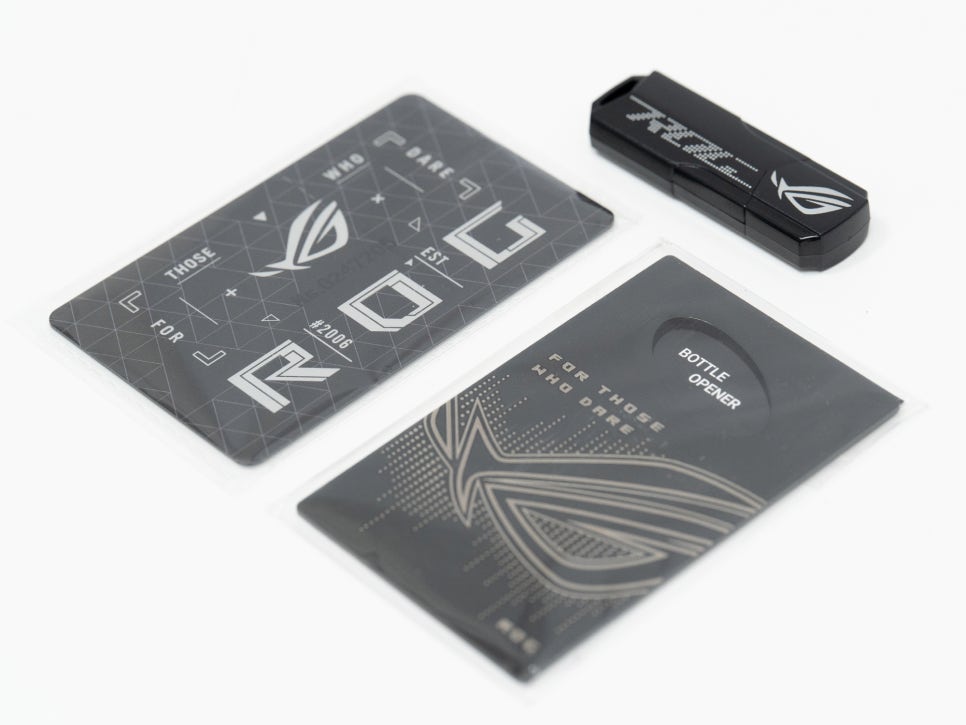
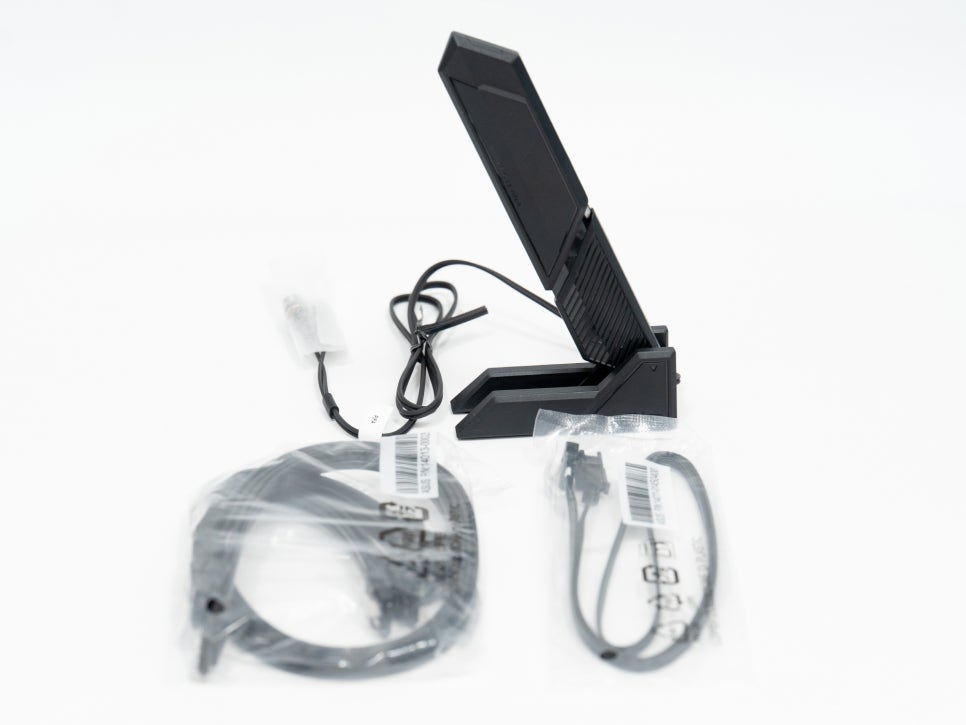
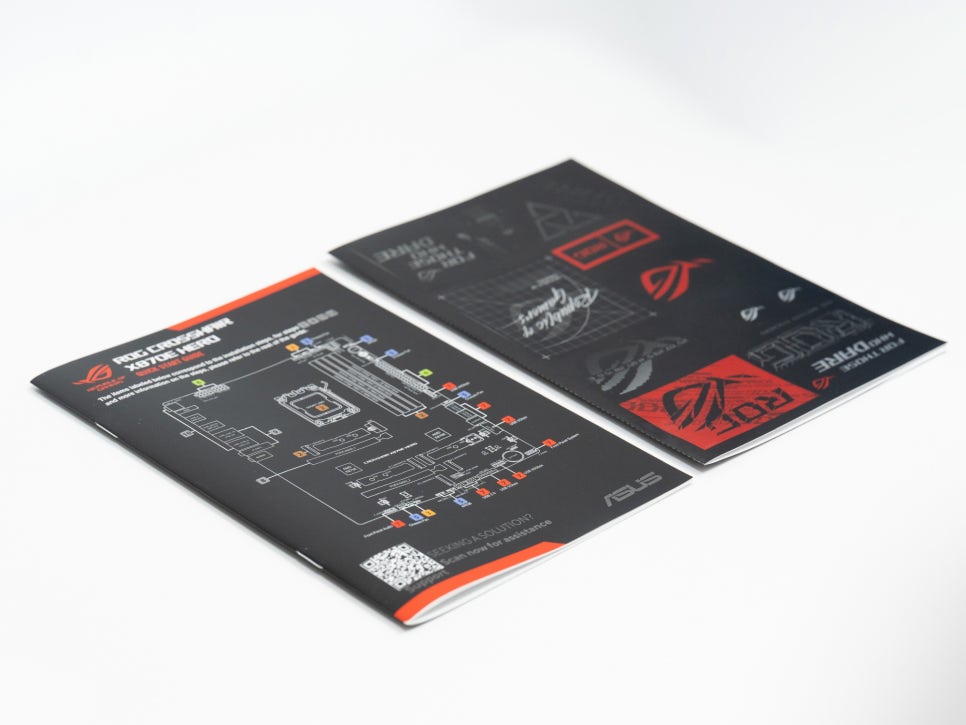
The ASUS ROG CROSSHAIR X870E HERO, as a premium motherboard, offers a rich and practical set of components. Most of what you need for motherboard assembly and installation is included, such as four SATA 6Gb/s cables, an ARGB extension cable, ASUS Q-Antenna supporting Wi-Fi 7, Q-Connector, two Q-Latch packages, three Q-Slide packages, five rubber packages, a utility and driver USB drive, and a quick start guide.
Appearance and Features
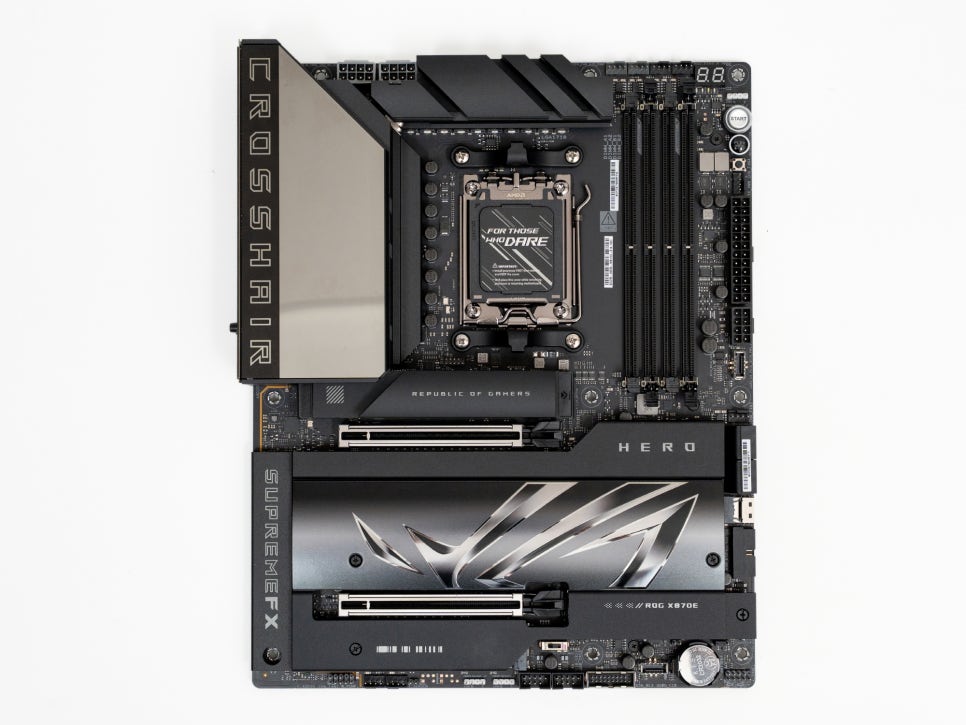
The ASUS ROG CROSSHAIR X870E HERO is designed in a standard ATX form factor, making it perfectly compatible with most mid-tower or larger cases. The most noticeable change in appearance is the newly improved Polymo Lighting II RGB array applied to the top of the I/O shroud, providing a splendid lighting effect when the motherboard is powered on.
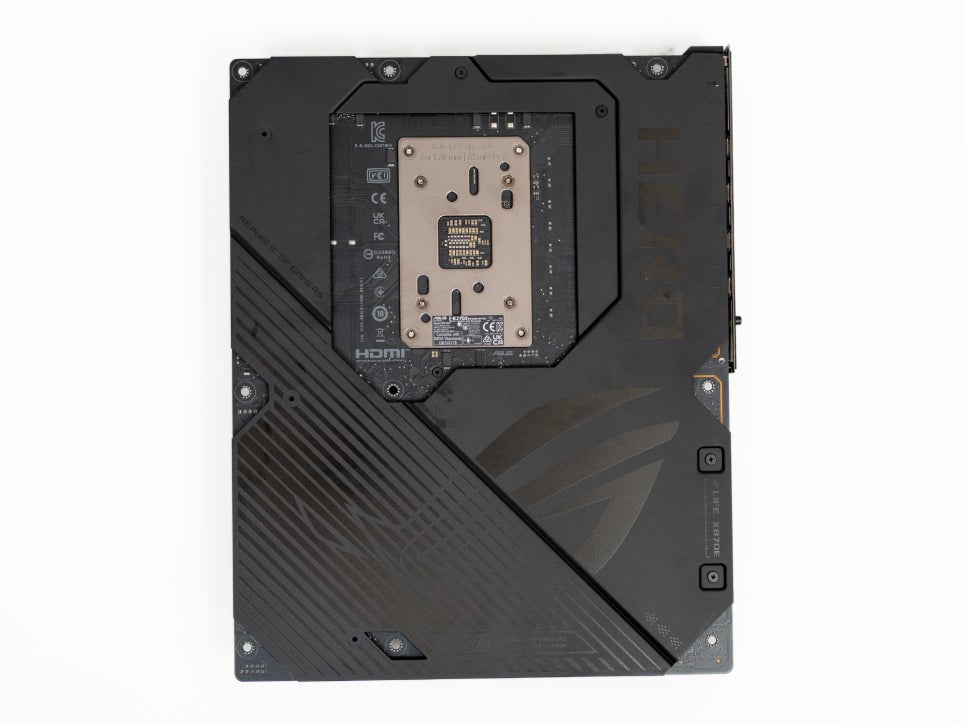
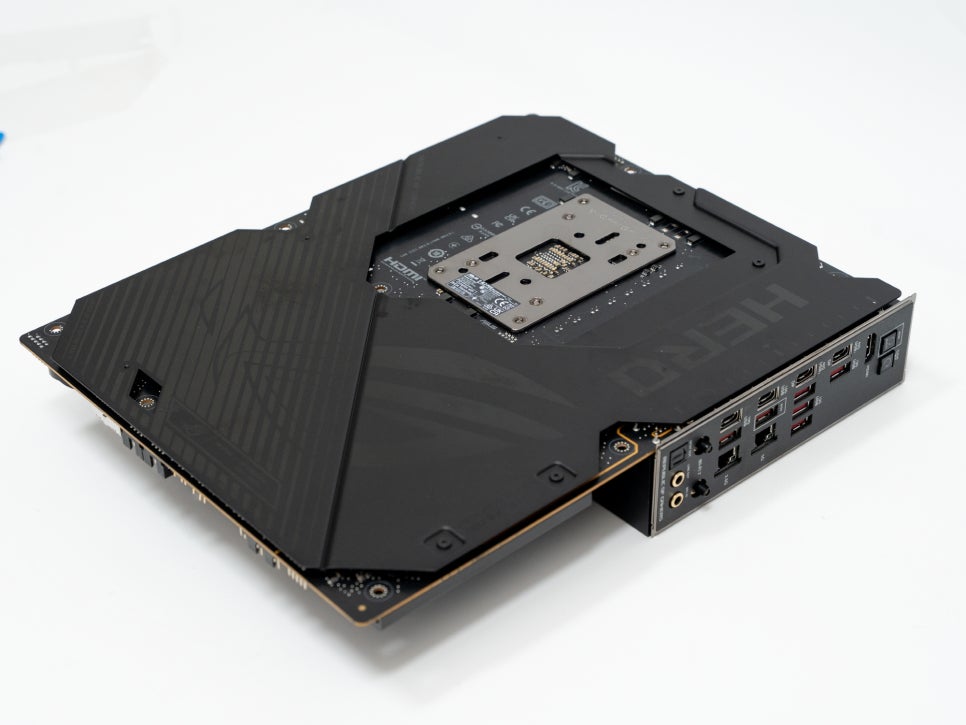
A particularly noteworthy feature is the reinforced metal backplate applied to the back of the motherboard. This backplate not only provides protection but also effectively prevents motherboard bending that can occur when mounting heavy high-performance coolers or graphics cards, while also offering additional heat dissipation.
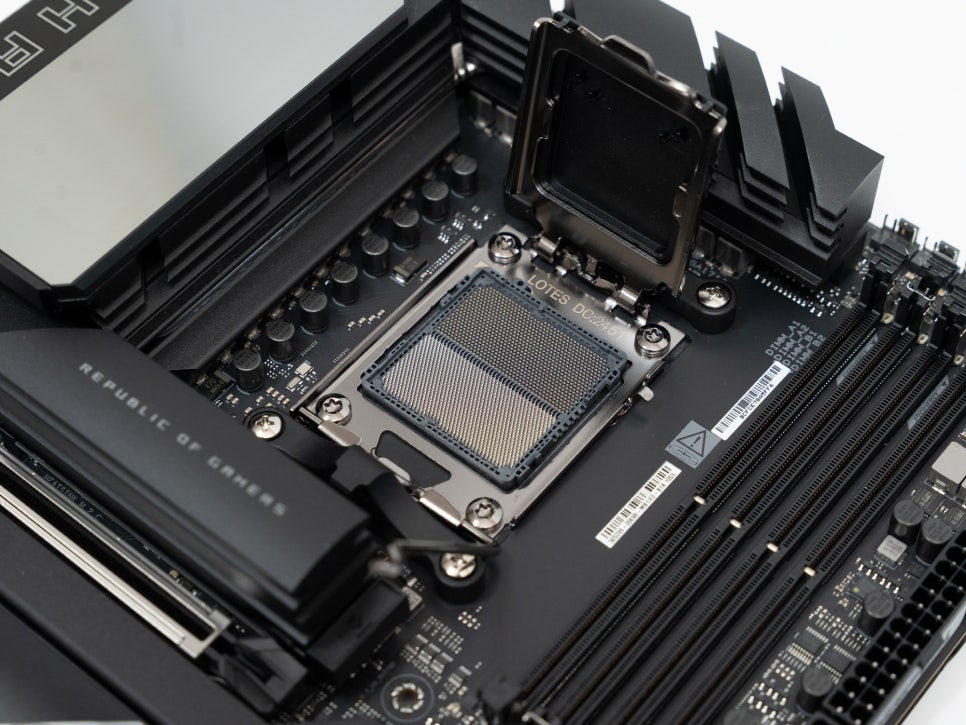
The AM5 socket supports up to 230W TDP, perfectly accommodating high-performance processors and ensuring compatibility with new processors until 2027 for long-term use.
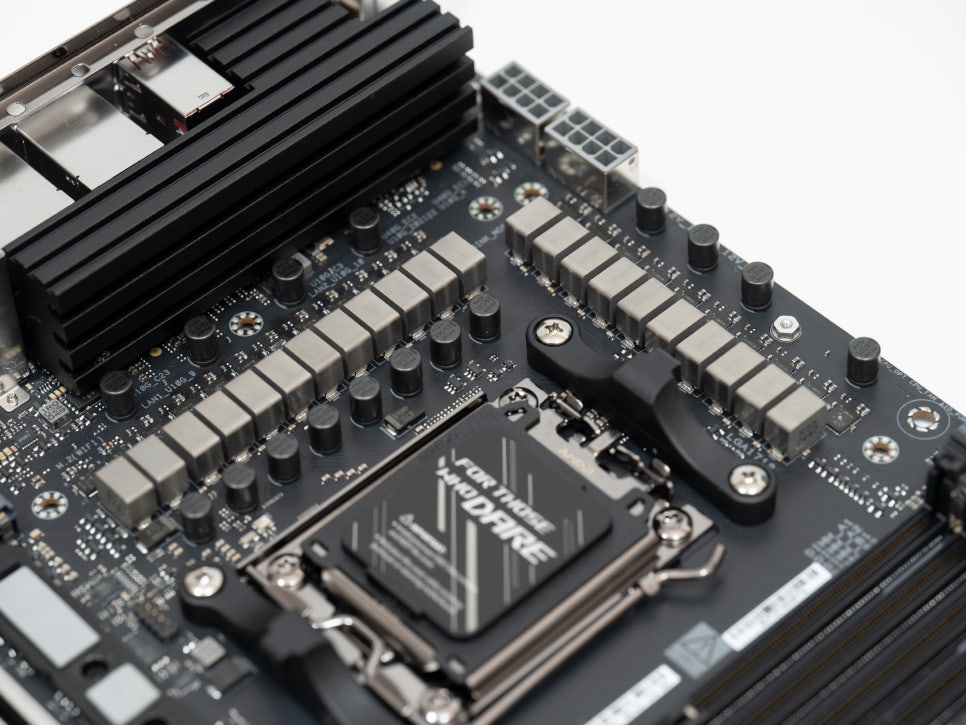
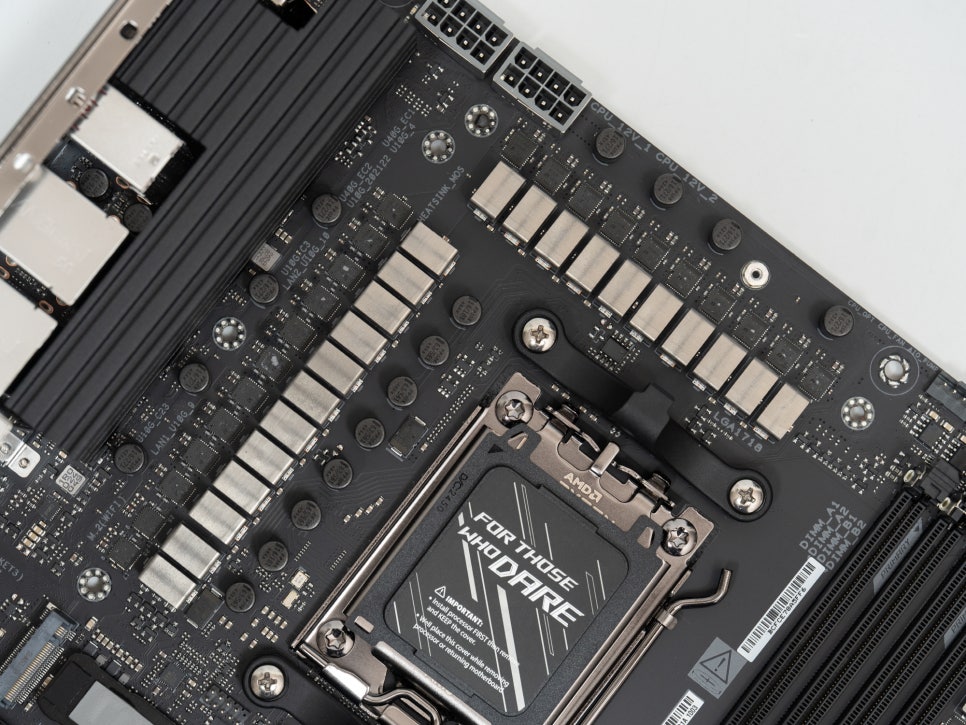
The power supply is configured with 18+2+2 phases, capable of supplying a total of 1,980A through 18 Vishay SiC850A 110A SPS MOSFETs. It offers precise voltage control through the Digi+ ASP2205 PWM controller and is designed to operate stably even in overclocking situations with a combination of large heatsinks with heat pipes.
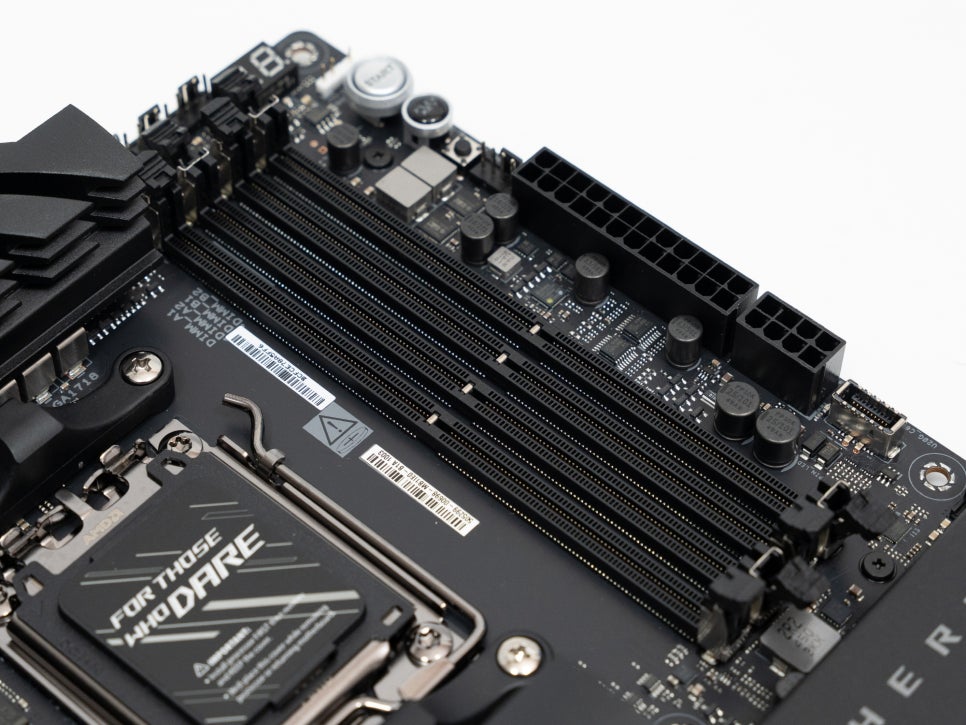
The memory slots provide four DIMM slots with Nitropath technology. They support up to 192GB and DDR5-8600+(OC). The core of Nitropath technology is to reduce signal interference, enhancing memory overclocking performance by 400MT/s and increasing module retention strength by 57% for improved stability.
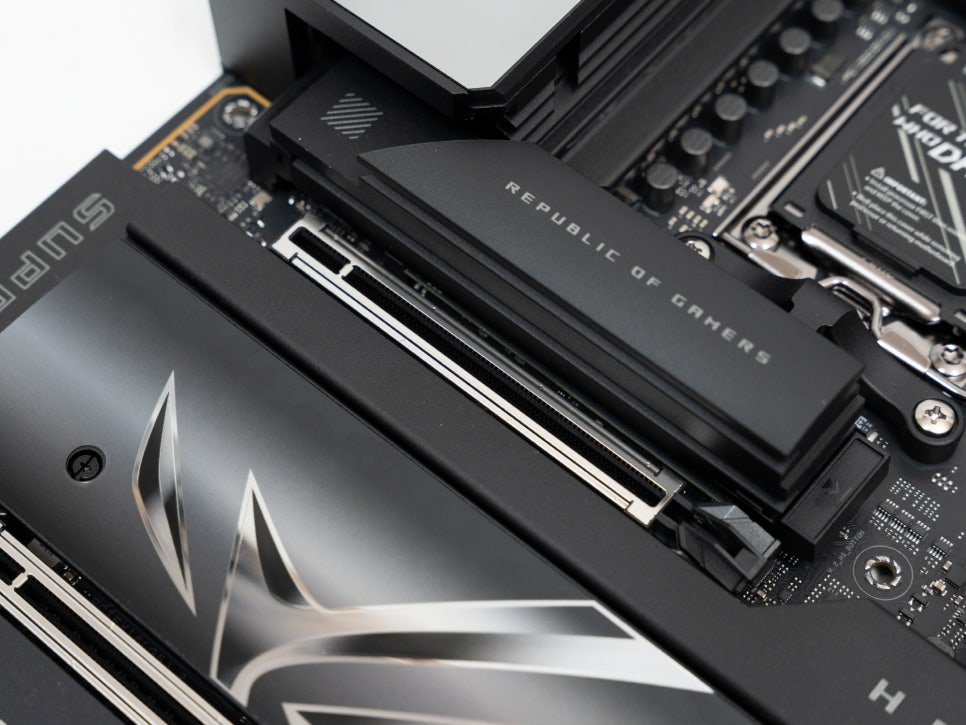
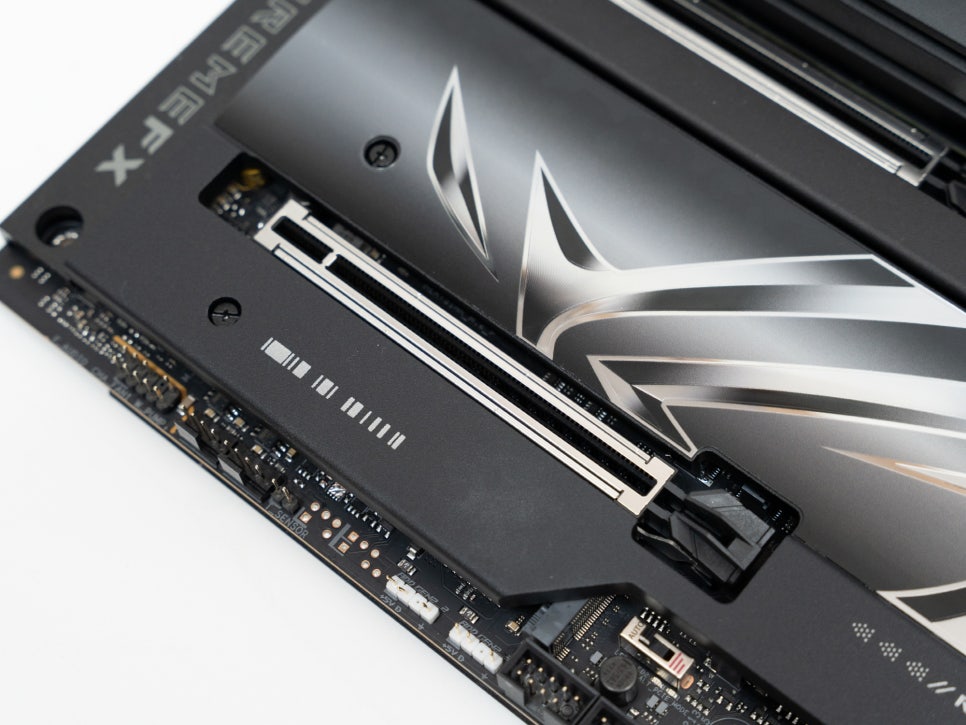
The PCIe slots offer two PCIe 5.0 x16 slots. The Q-Release Slim feature allows for easy attachment and detachment of graphics cards without buttons, a feature I personally find very appealing.
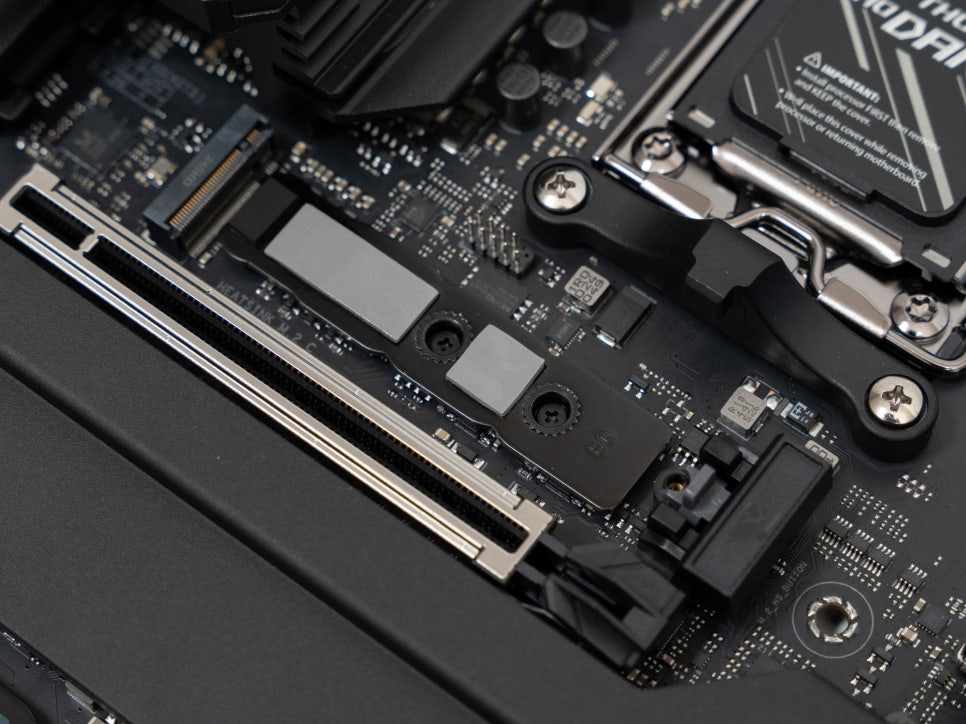
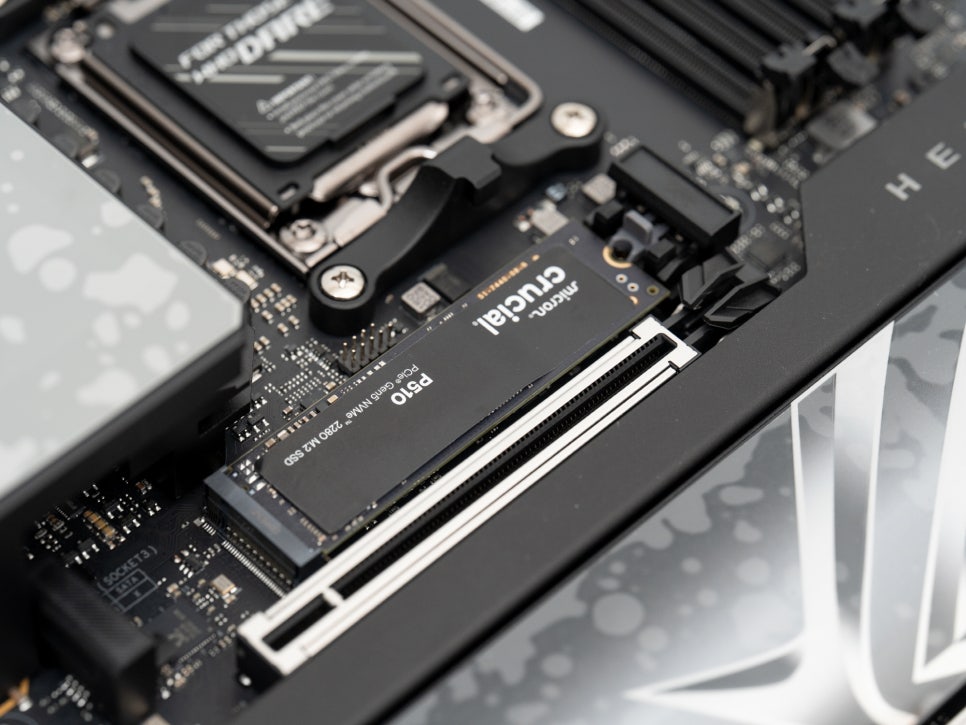
The ASUS ROG CROSSHAIR X870E HERO from Daewon CTS provides a total of five M.2 slots, with three of them being PCIe 5.0 x4 slots directly connected to the CPU, offering up to 128Gbps bandwidth, and the remaining two being PCIe 4.0 x4 slots connected through the X870E chipset, providing 64Gbps bandwidth. The main M.2 slot offers M.2 Q-Release and Q-Slide features for easy installation.
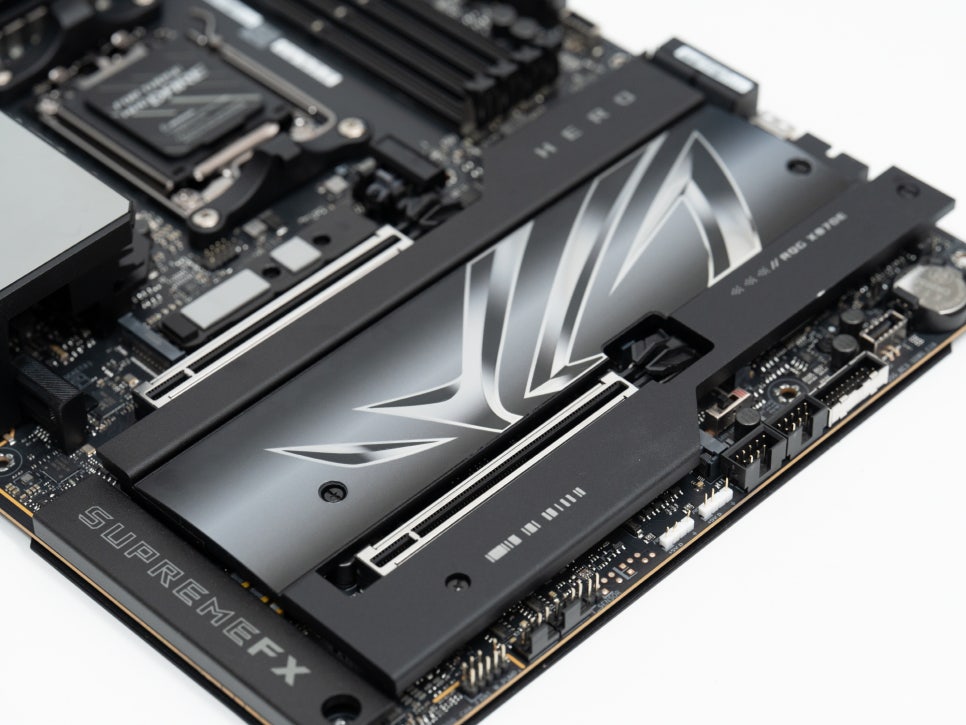
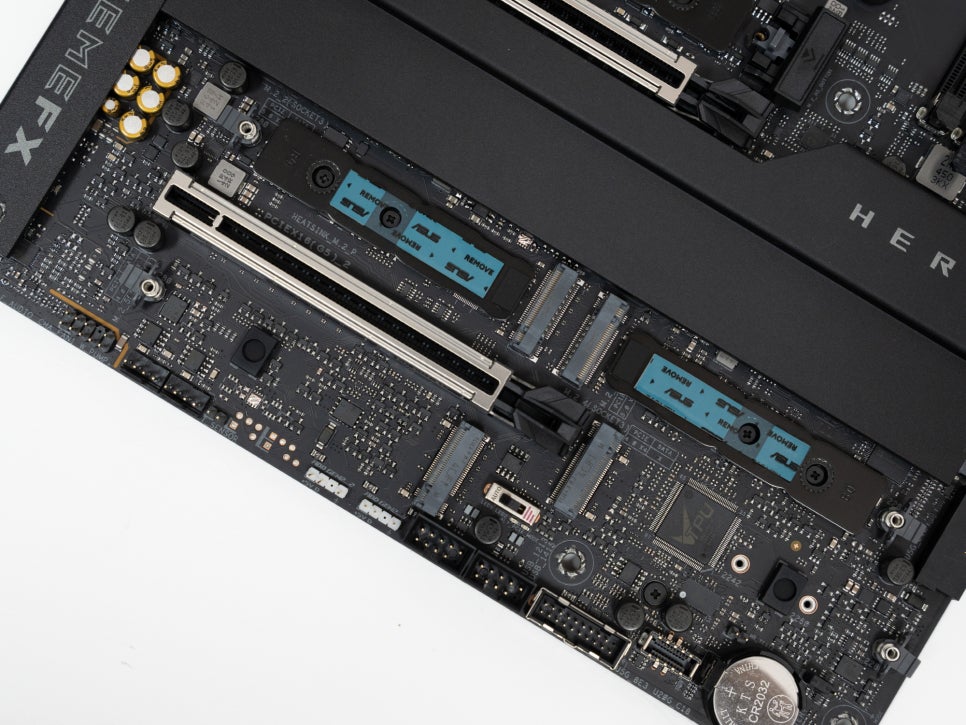
Additionally, the four extra M.2 slots are equipped with M.2 Q-Latch for easy installation without screws. All M.2 slots come with dedicated thermal pads on the backplate to effectively address the heat issues of high-performance SSDs.
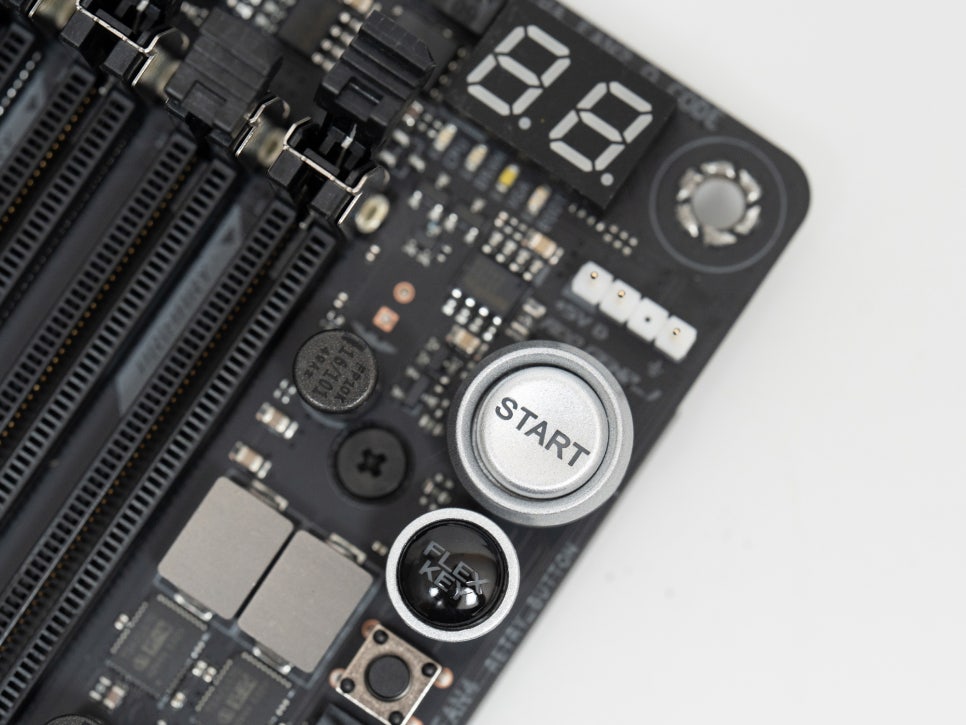
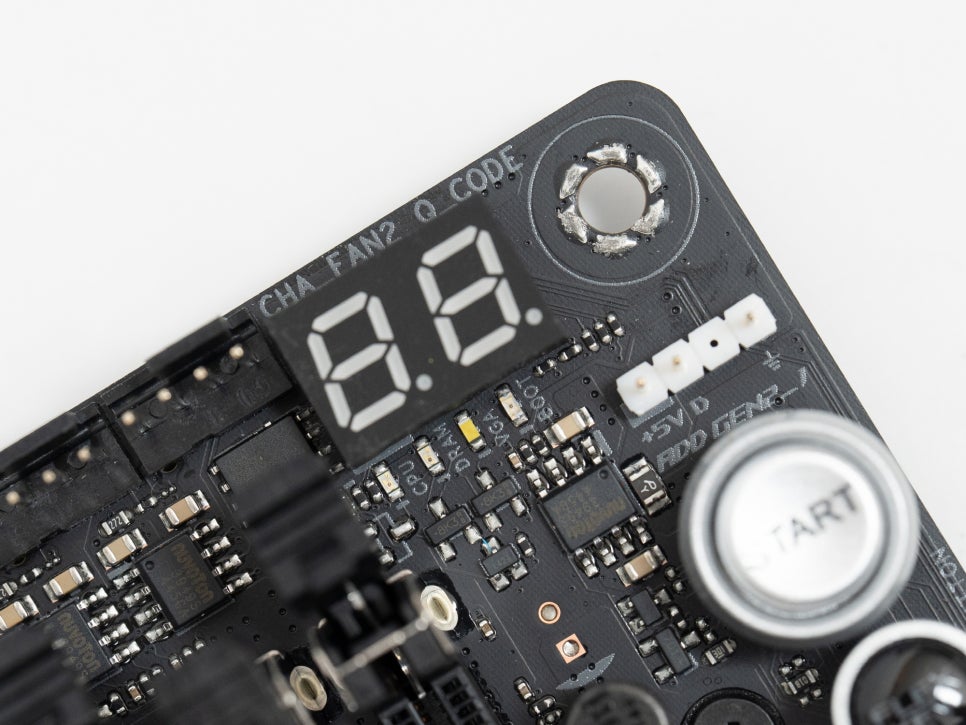
Convenience features include a Start button for booting the system directly from the motherboard without case connections, and Q-LED and Q-Code for visually displaying issues during the boot process to simplify troubleshooting.
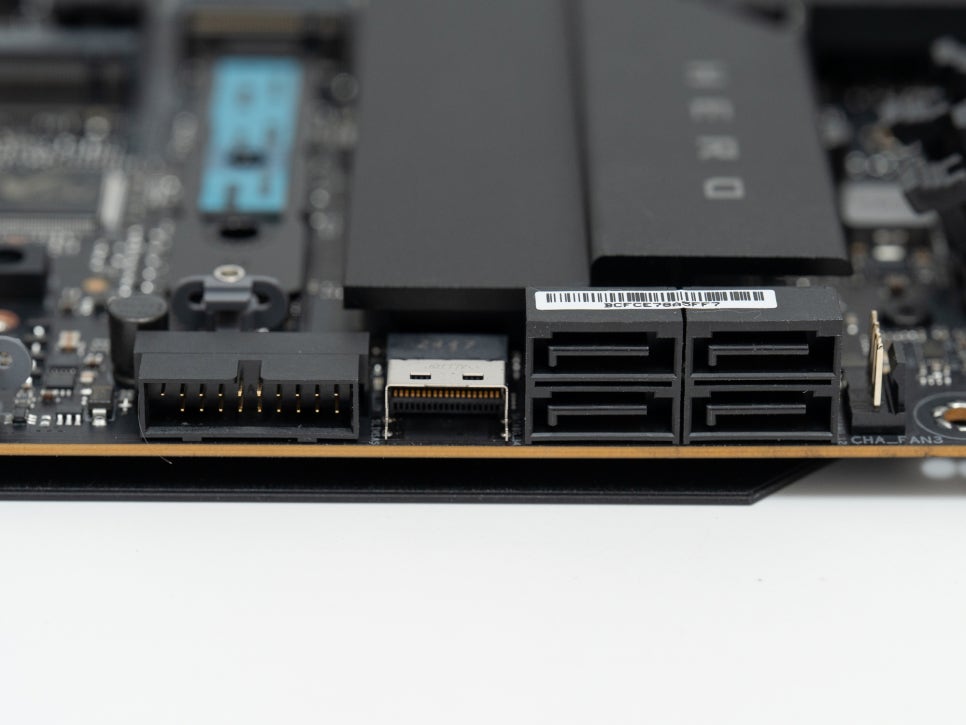
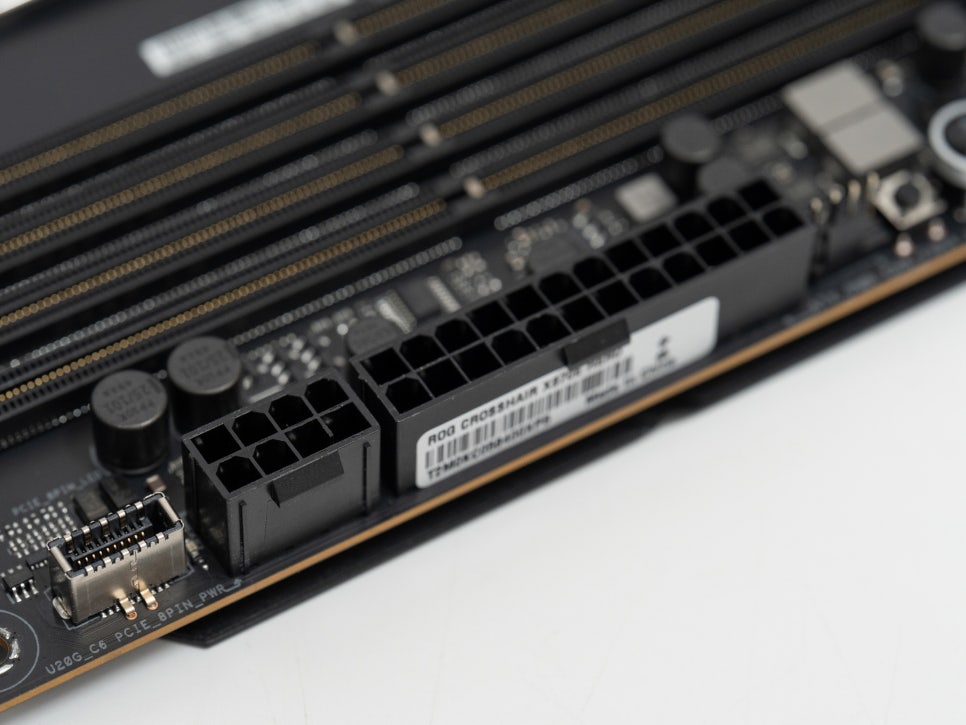
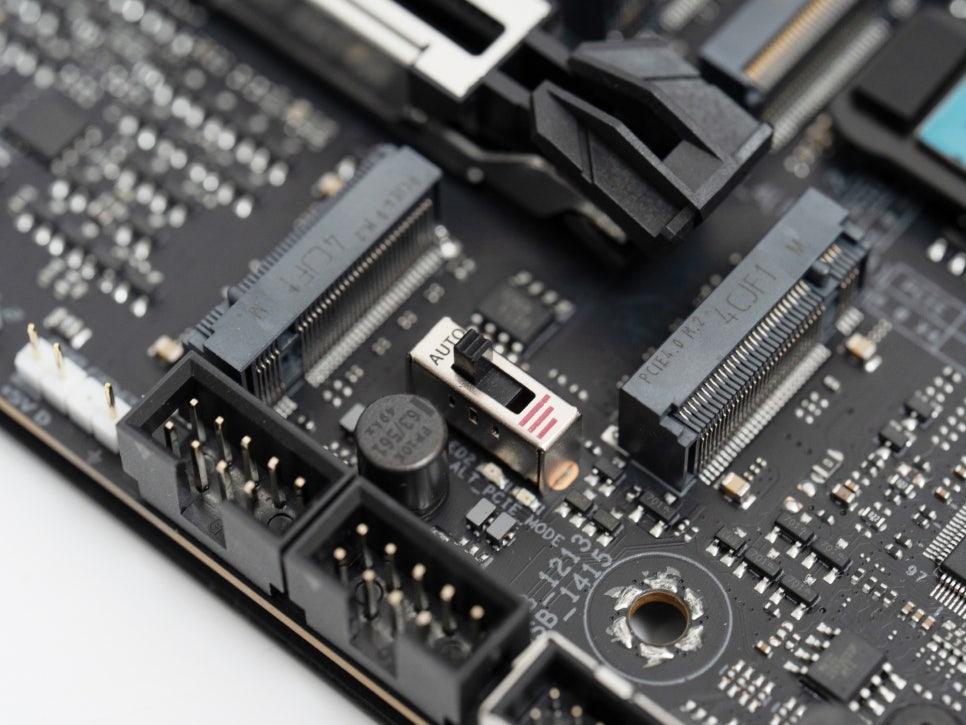

The diverse port configuration includes a USB 3.2 Gen 2×2 Type-C header supporting 60W PD/QC4+, eight 4-pin fan headers including CPU, CPU_OPT, AIO_PUMP, CHA_FAN, and three aRGB Gen 2 headers.
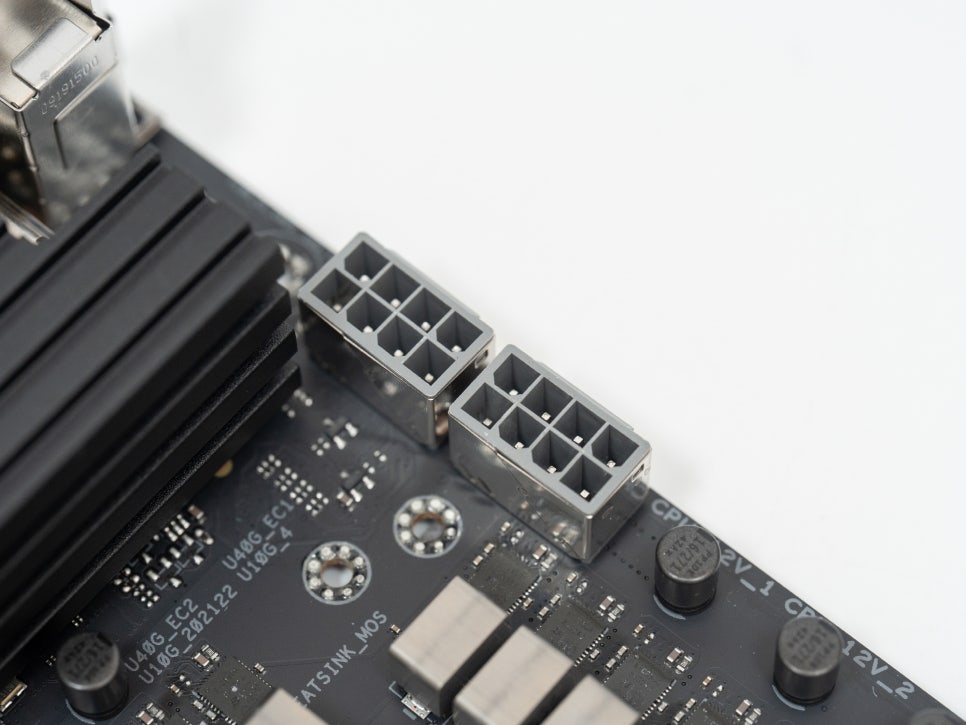
The power connector uses an 8+8 pin ProCool II power connector. This connector, exclusive to ASUS, minimizes contact resistance and allows for stable power delivery. The area around the connector is metal-finished to minimize damage to the contact area even with frequent connections and disconnections.
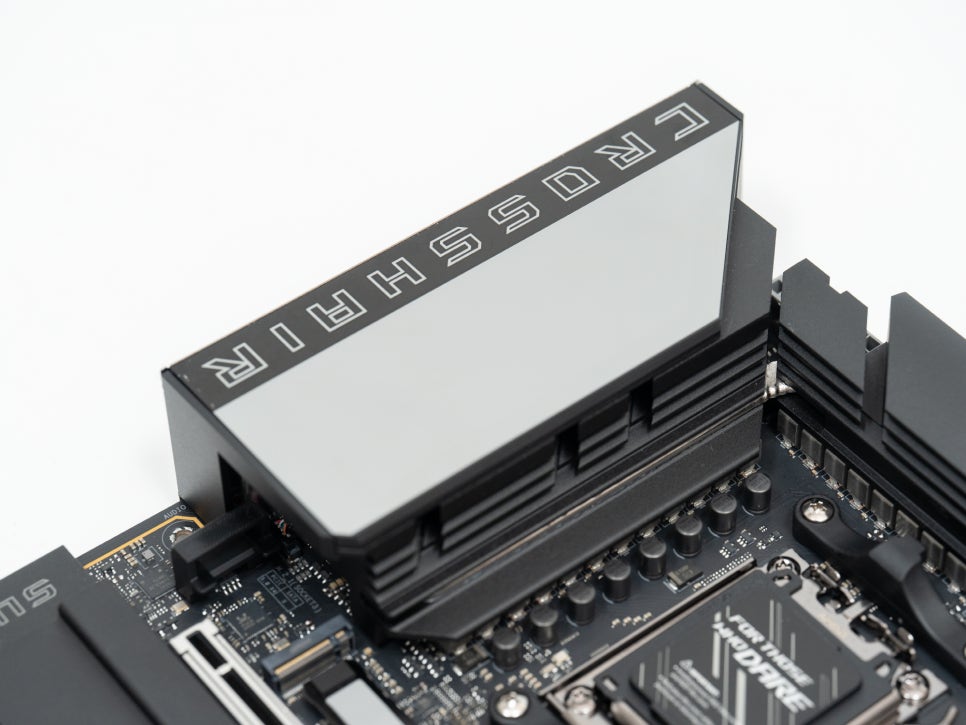
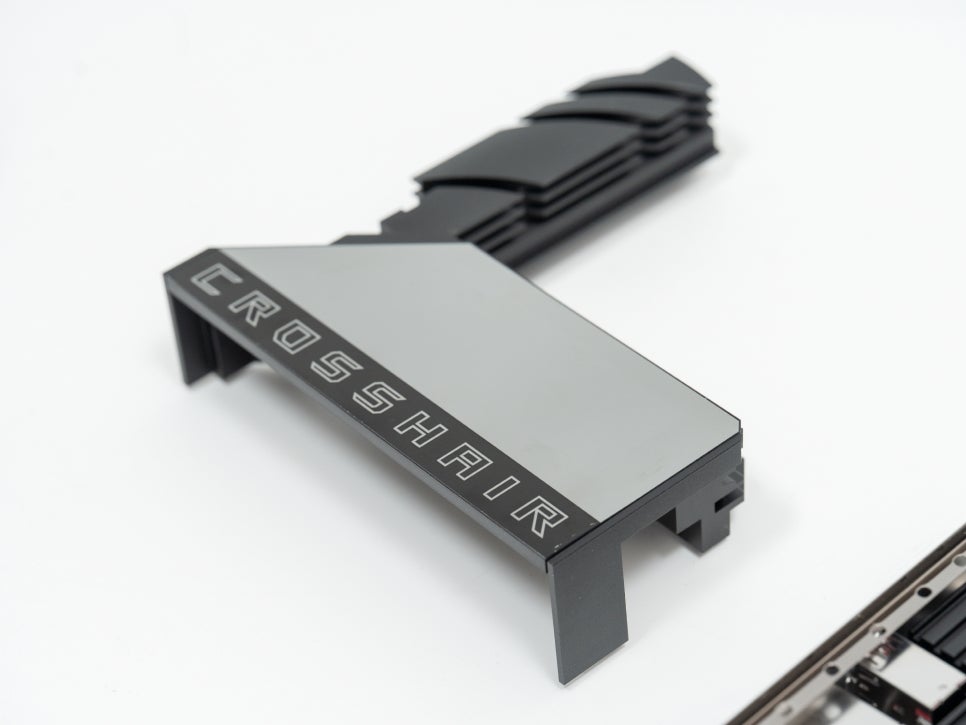
The I/O cover and VRM heatsink are made of large aluminum heatsinks connected by heat pipes for heat dissipation.
Chipset
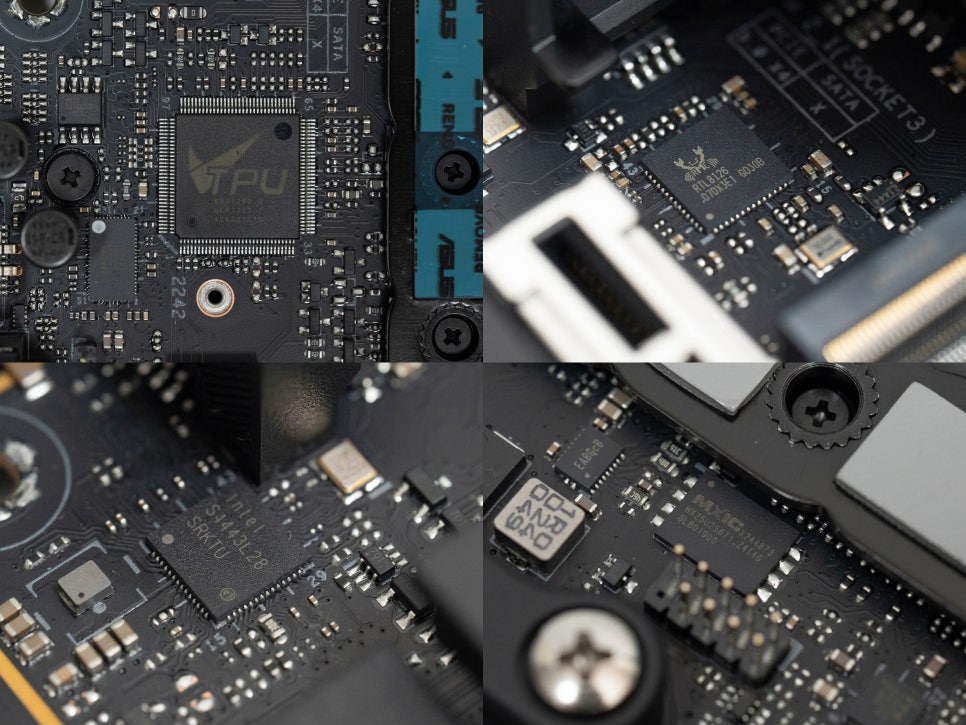
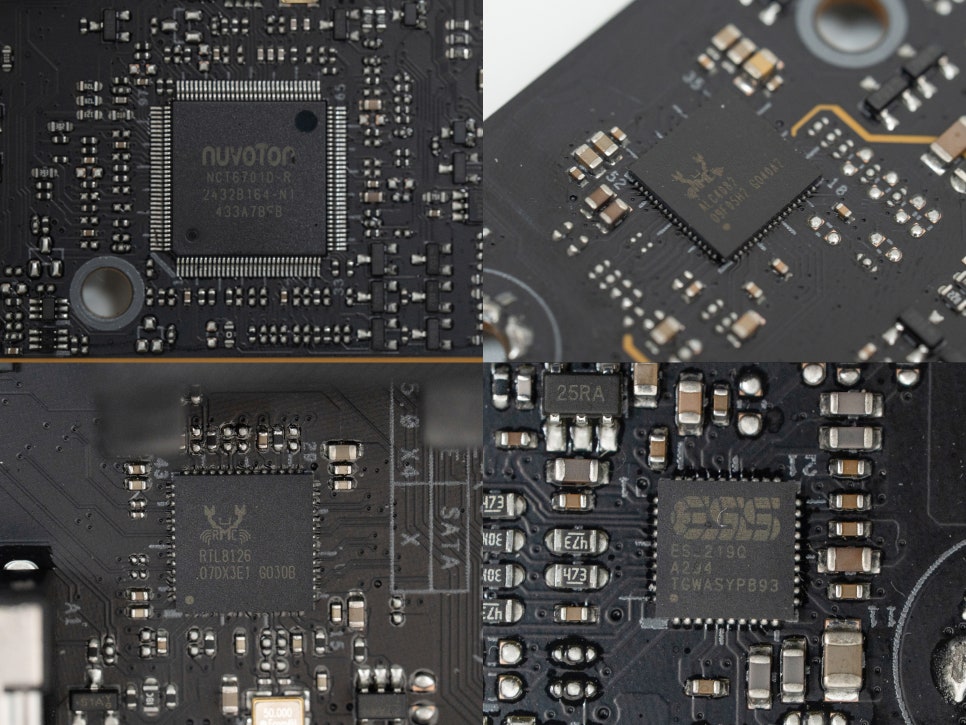
The chipset used includes the Realtek ALC4082 audio codec, ASMedia ASM4242 USB4 controller, Intel I226-V and Realtek RTL8126 network chipsets, and MediaTek MT7927 wireless chipset.
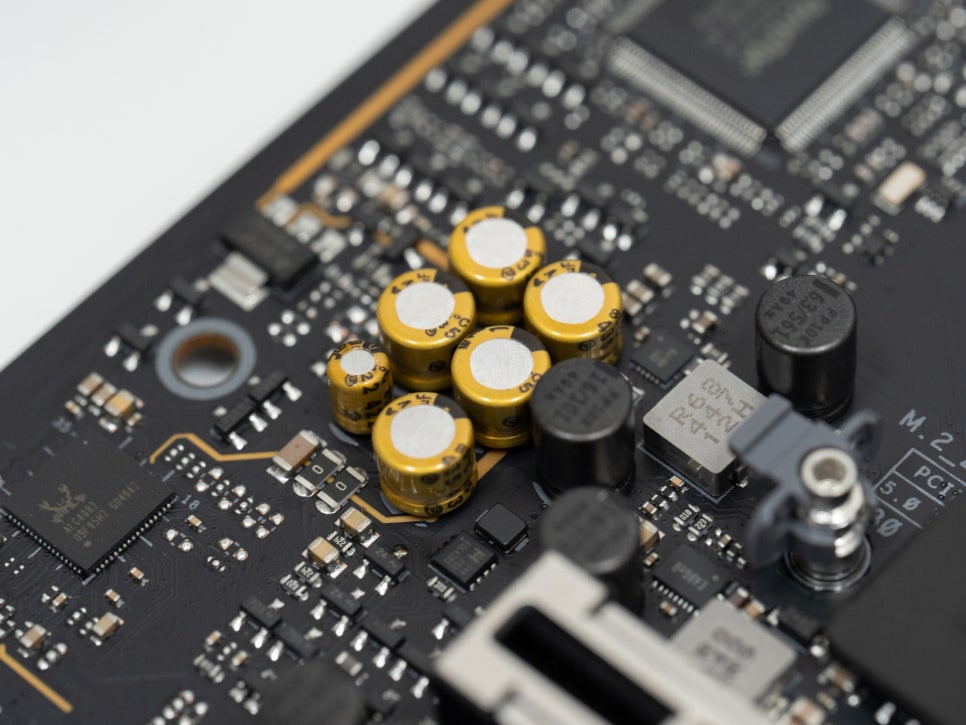
In the audio section, the SupremeFX 7.1 ALC4082 audio codec is applied. The combination of the Realtek ALC4082 codec and ESS Sabre9219 DAC provides audiophile-grade sound. With 120dB SNR, it reproduces studio-quality sound with fine details, and the impedance sensing feature automatically detects headphone impedance for optimal output. It uses independent PCB area design, premium audio capacitors, and a metal shroud to shield EMI for digital noise reduction.
I/O Ports
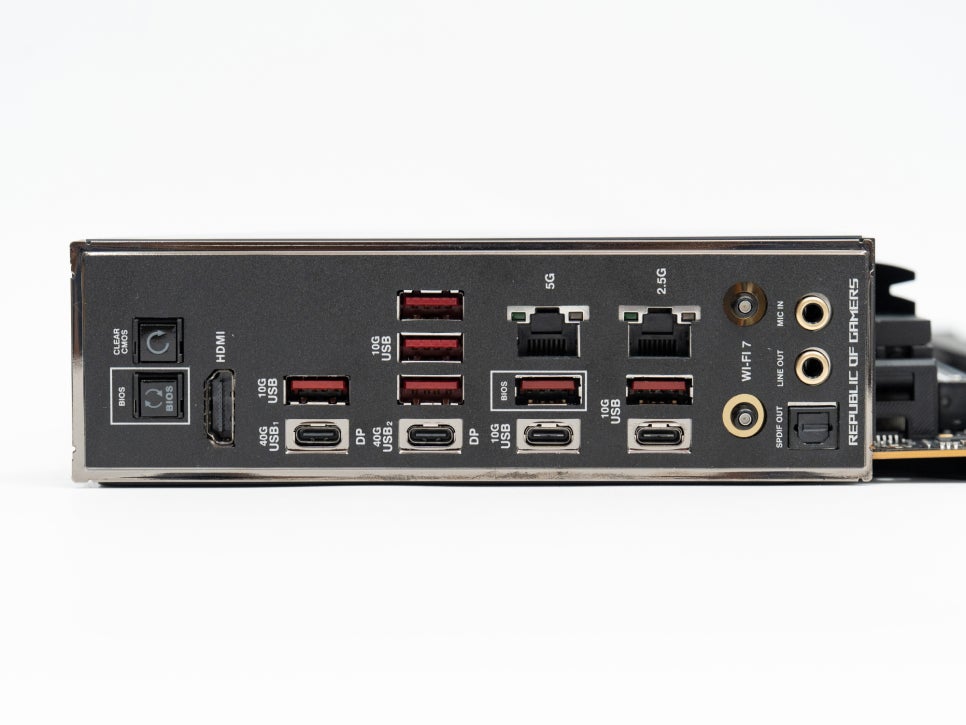
The rear I/O port configuration offers a total of 10 USB ports, including two USB4 40Gbps Type-C ports supporting DisplayPort, two USB 3.2 Gen 2 Type-C ports at 10Gbps, and six USB 3.2 Gen 2 Type-A ports at 10Gbps. For network ports, it provides Intel i-226 2.5GbE LAN and Realtek 8126 5GbE LAN for flagship-level high-speed wired connections. For video output, it offers one HDMI 2.1 port and two USB-C DisplayPort ports that double as 40Gbps USB4 ports, making it very useful for those configuring systems with more than four multi-screens.
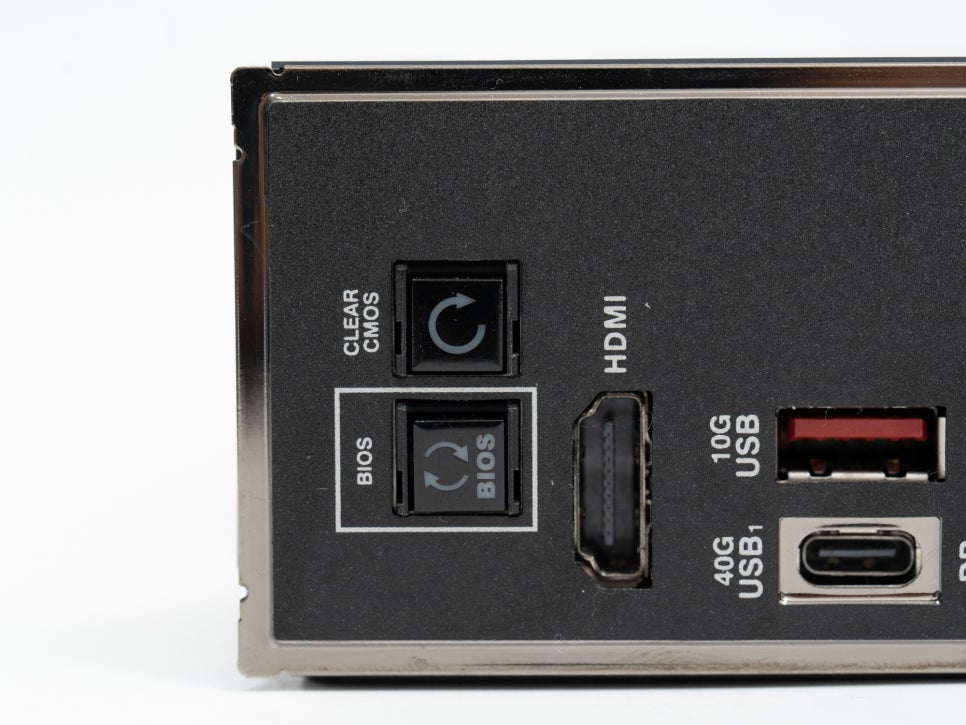
Special function buttons include a BIOS Flashback button for updating BIOS without a CPU or memory and a Clear CMOS button for easily resetting settings after overclocking failures.
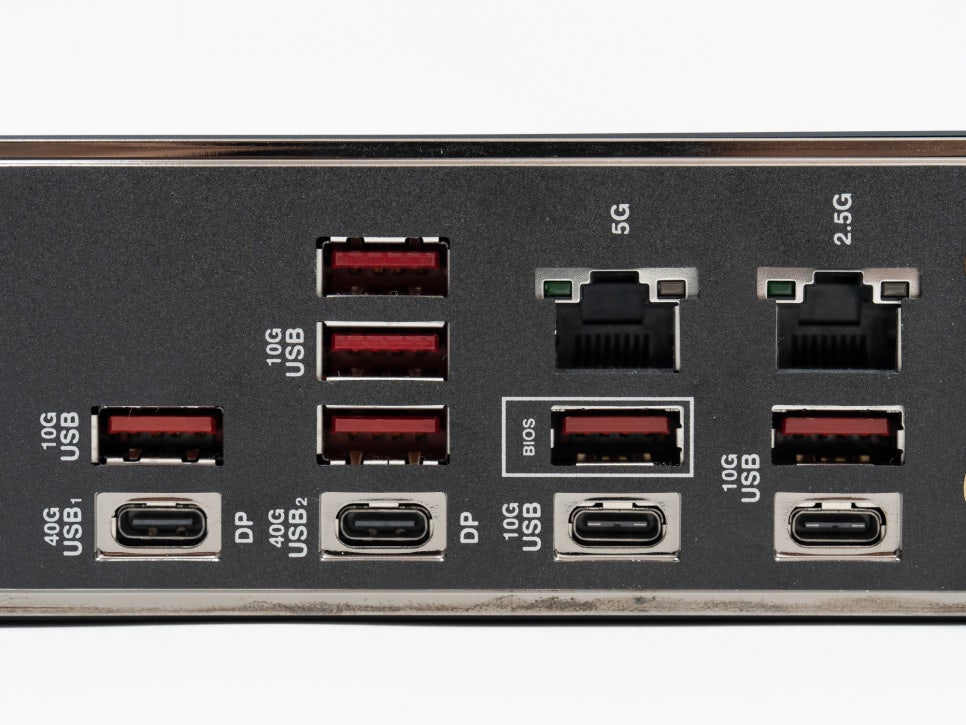
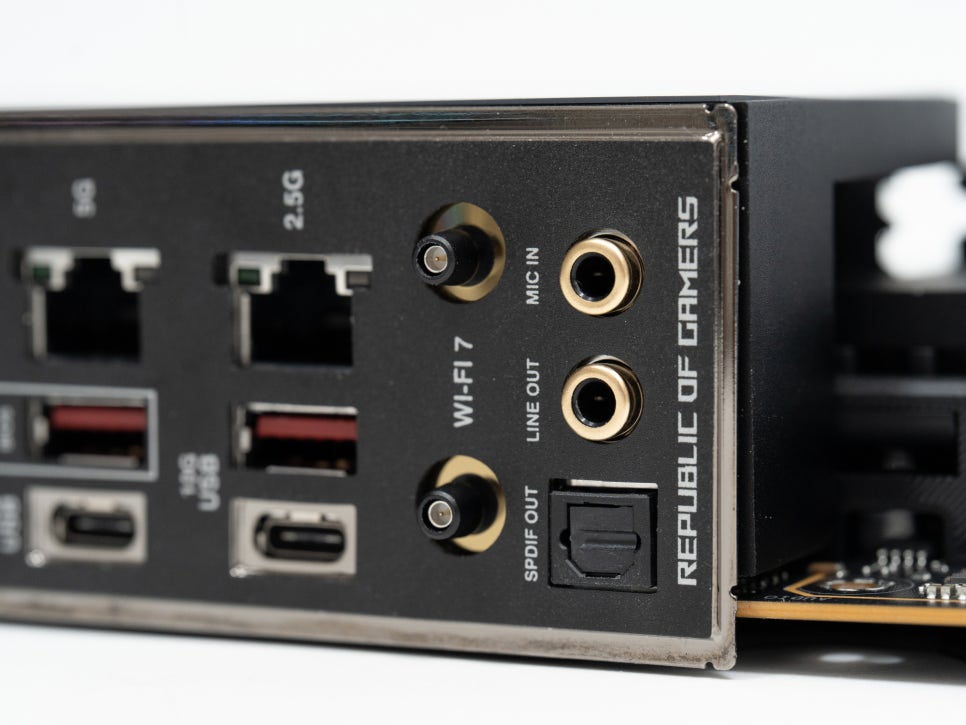
It supports the latest Wi-Fi 7 standard, offering theoretical speeds of up to 5.8Gbps through 2×2 320MHz, 6GHz bands, and provides low-latency connections optimized for gaming and Bluetooth 5.4 for connecting various devices. The included Q-Antenna ensures stable signal reception, allowing for wireless speeds equivalent to wired in gigabit internet environments.
System Configuration
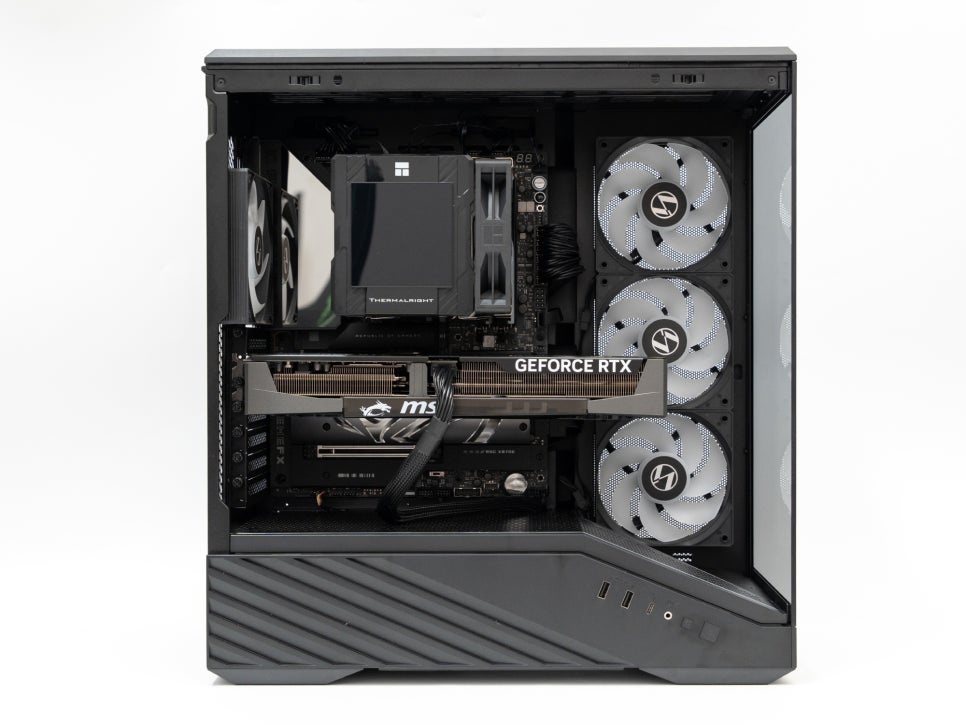
System Configuration
CPU: AMD Ryzen 7 9800X3D
GPU: RTX 5070
MB: ASUS ROG CROSSHAIR X870E HERO
RAM : G.Skill DDR5 TRIDENT Z5 RGB 48GB CL40
In this review, we configured a system using the AMD Ryzen 7 9800X3D. The AMD 9800X3D is currently the top-level processor for gaming, making it the optimal CPU to fully utilize the performance of the X870E Hero.
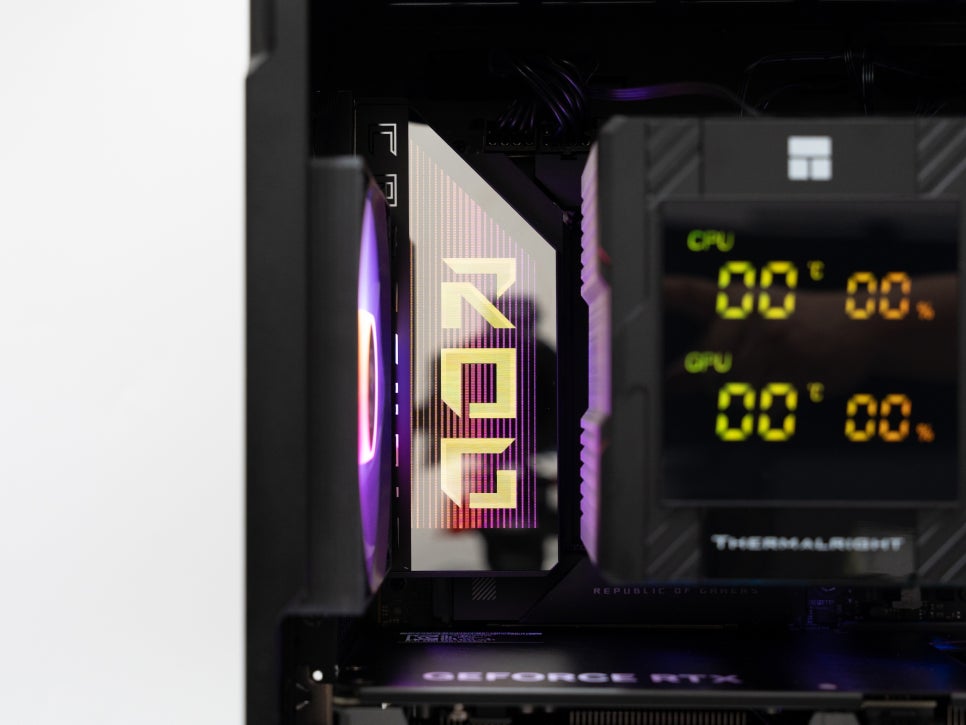
BIOS
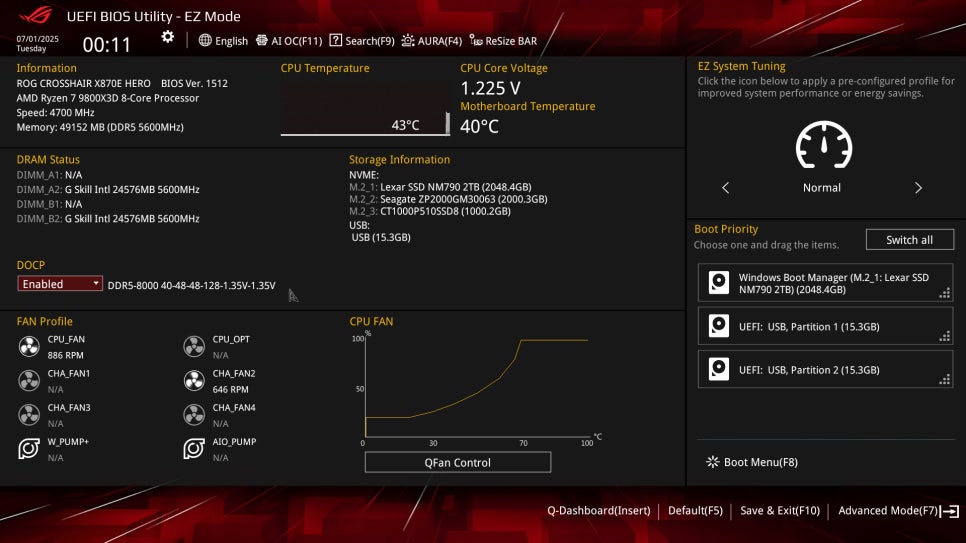
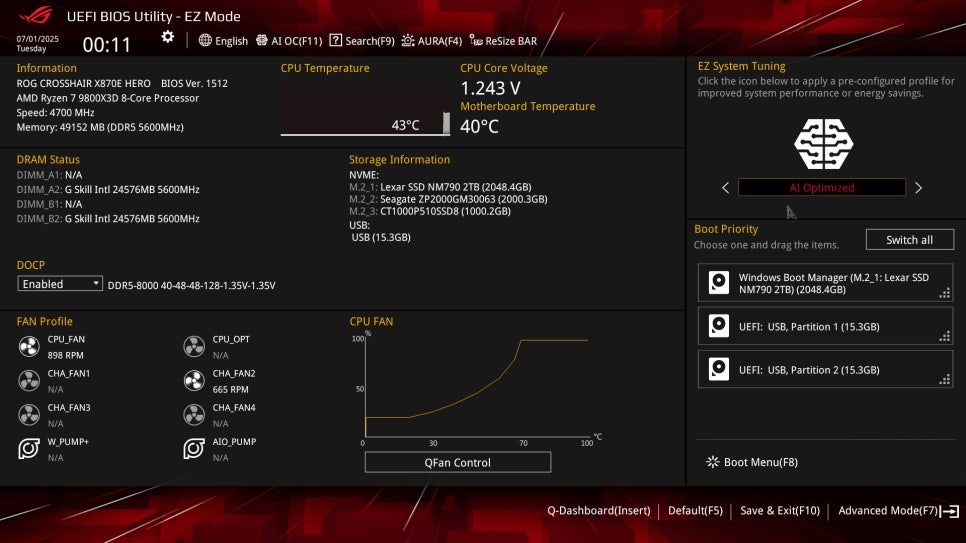
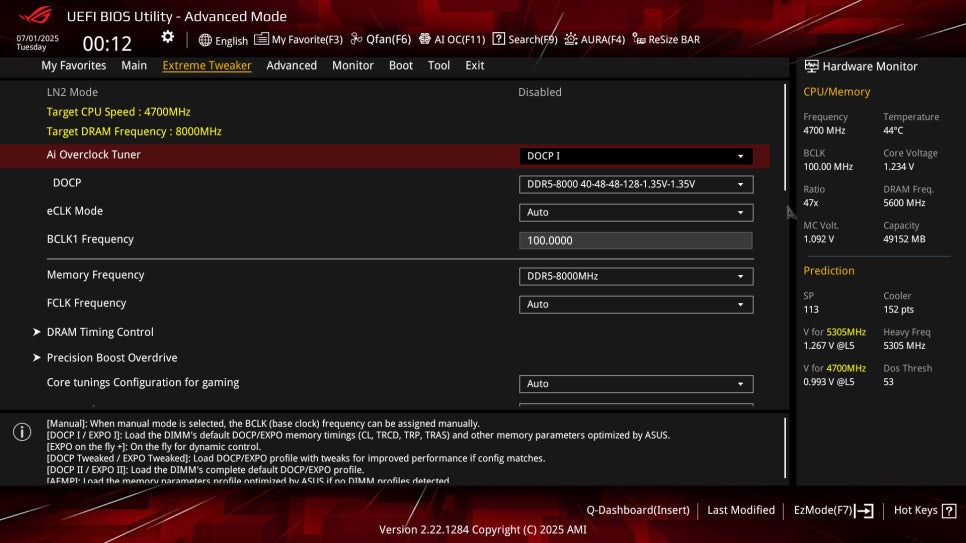
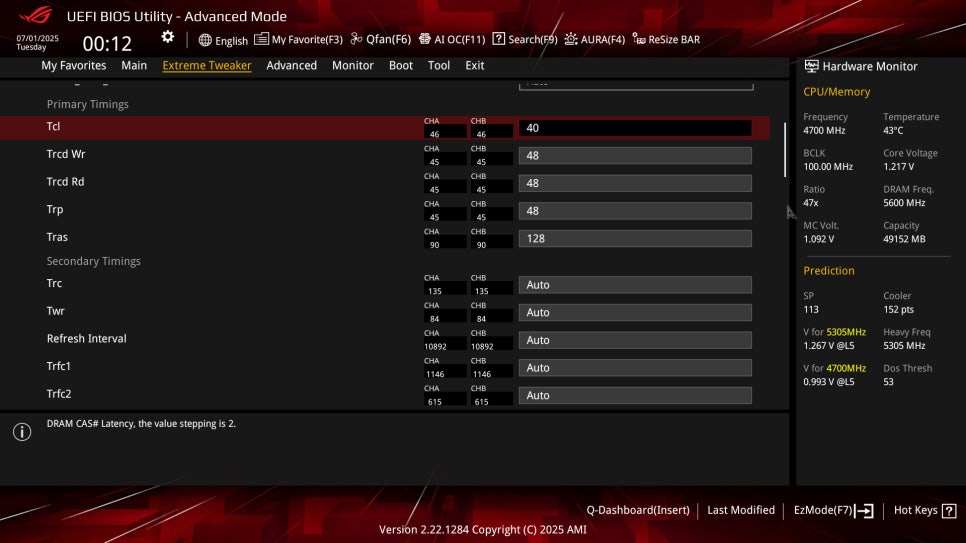
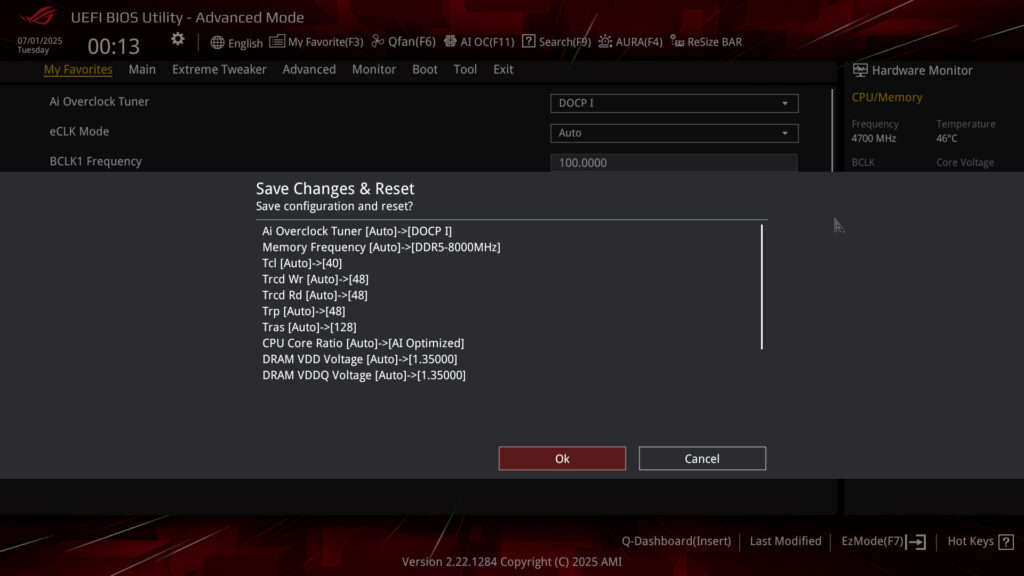
ASUS UEFI BIOS features an intuitive UI, divided into EZ Mode for easy access by beginners and Advanced Mode for detailed settings. It provides monitoring functions that display temperature, voltage, and fan speeds in real-time, along with profile saving features that allow you to store and quickly switch between multiple overclocking settings.
Among these, the AI Optimizer function uses artificial intelligence-based automatic optimization to find optimal settings for your system automatically. It offers AI overclocking that automatically sets optimal clocks for CPU and memory, fan curve optimization that creates cooling profiles suited to your system configuration, power efficiency mode that searches for the optimal balance between performance and power consumption, and gaming turbo mode that automatically enhances performance during game execution.
Benchmarking
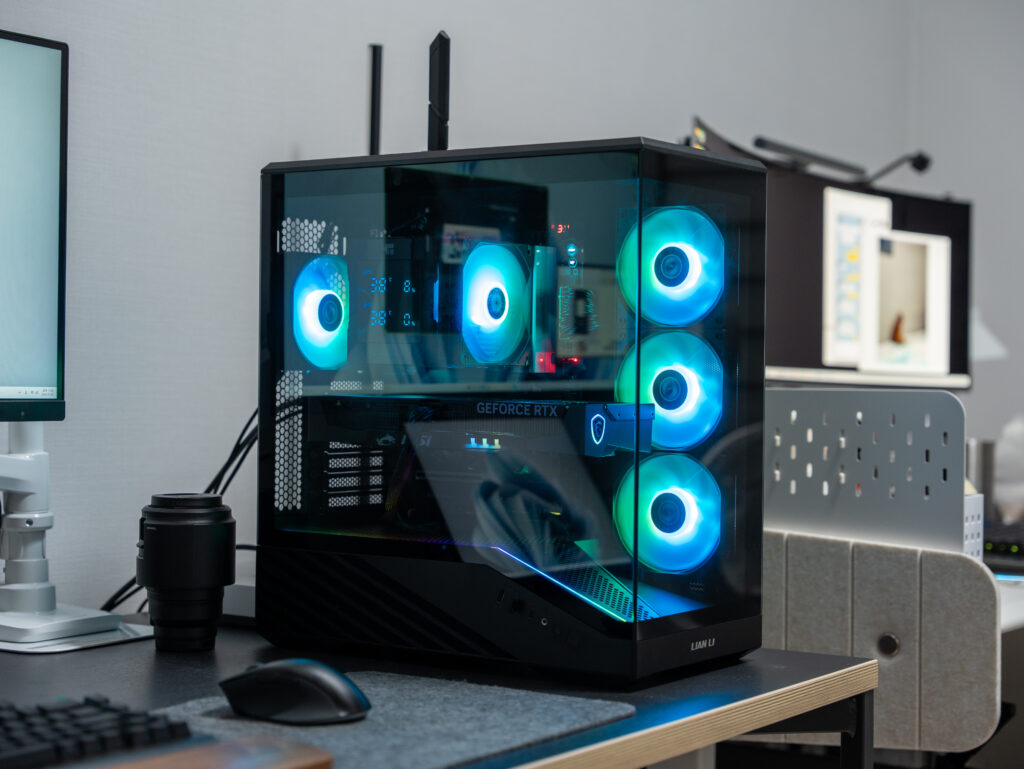
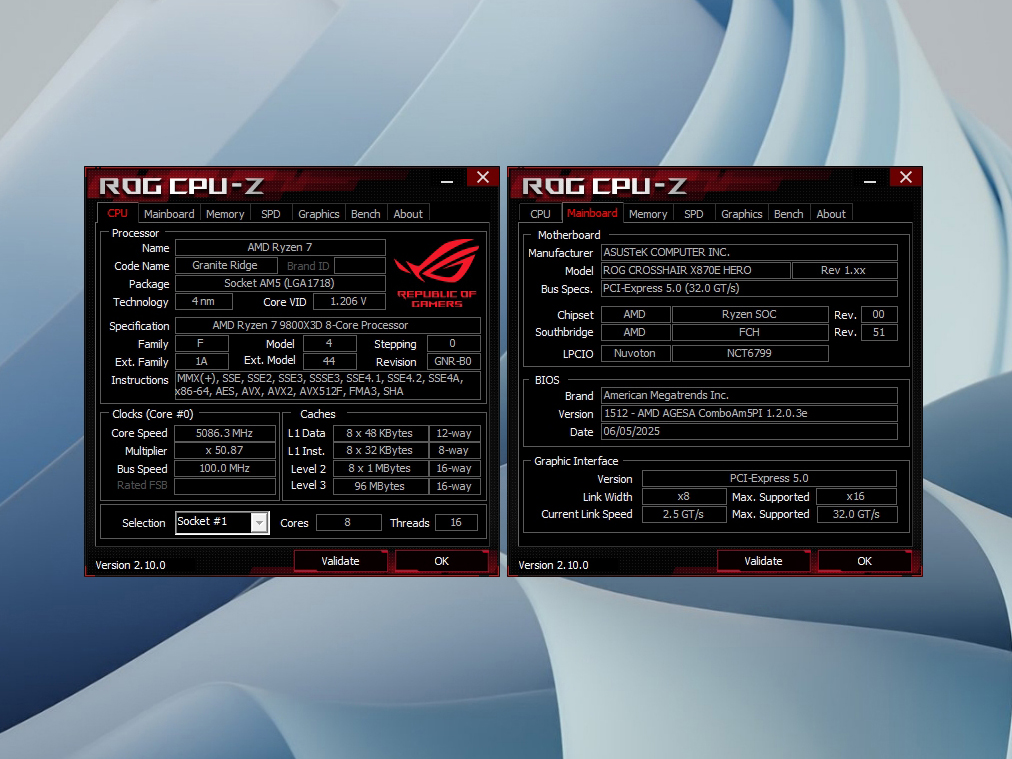
Running CPU-Z confirmed that hardware was properly recognized and operating at optimal performance. All specifications of the 9800X3D were perfectly recognized, and boost clocks operated normally up to 5.2GHz as specified.
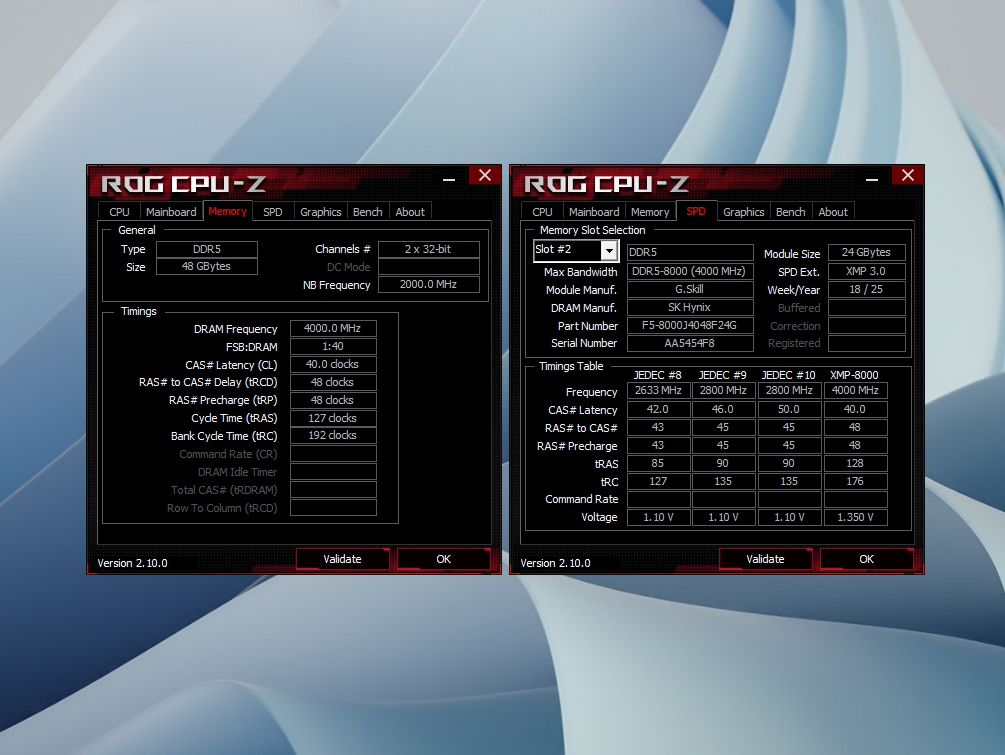
We used G.Skill DDR5-8000MHz TRIDENT Z5 RGB 48GB CL40 memory. Thanks to the X870E Hero’s Nitropath technology, high-clock memory operated stably, providing direct benefits to gaming performance. The combination of 9800X3D and high-clock memory particularly showed excellent performance in gaming environments.
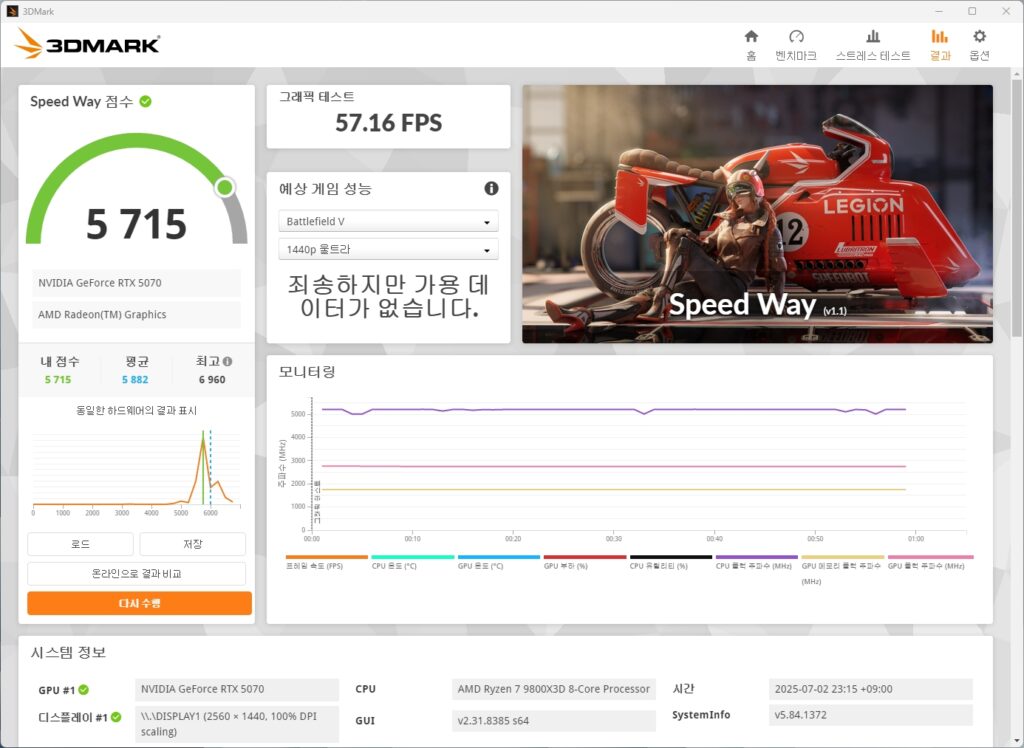
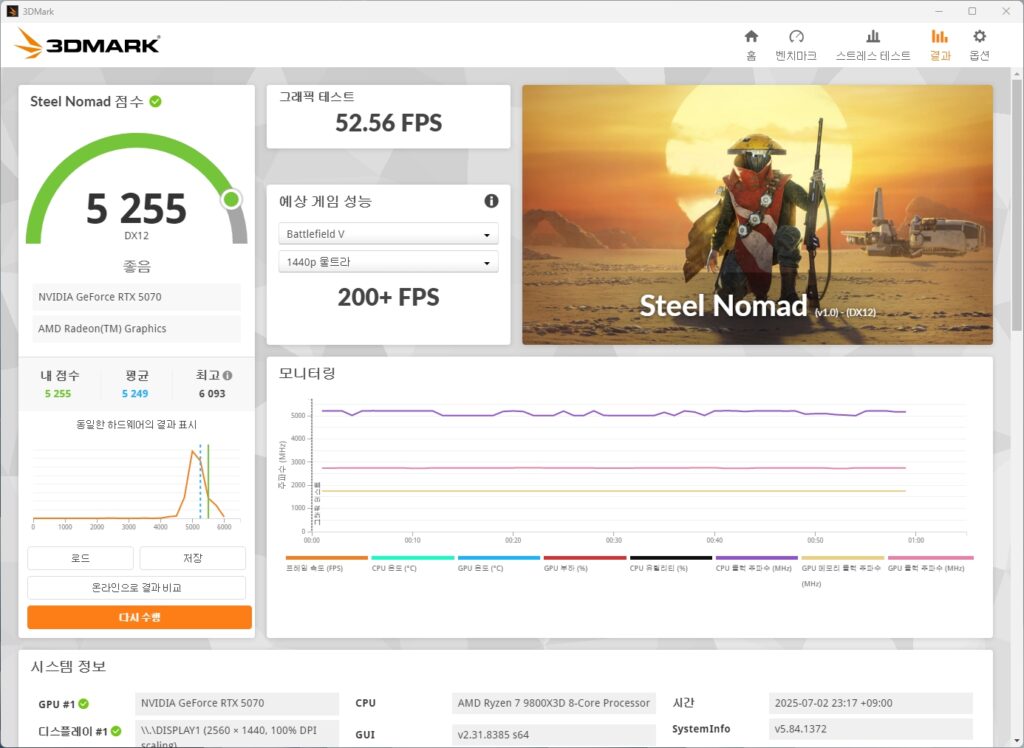
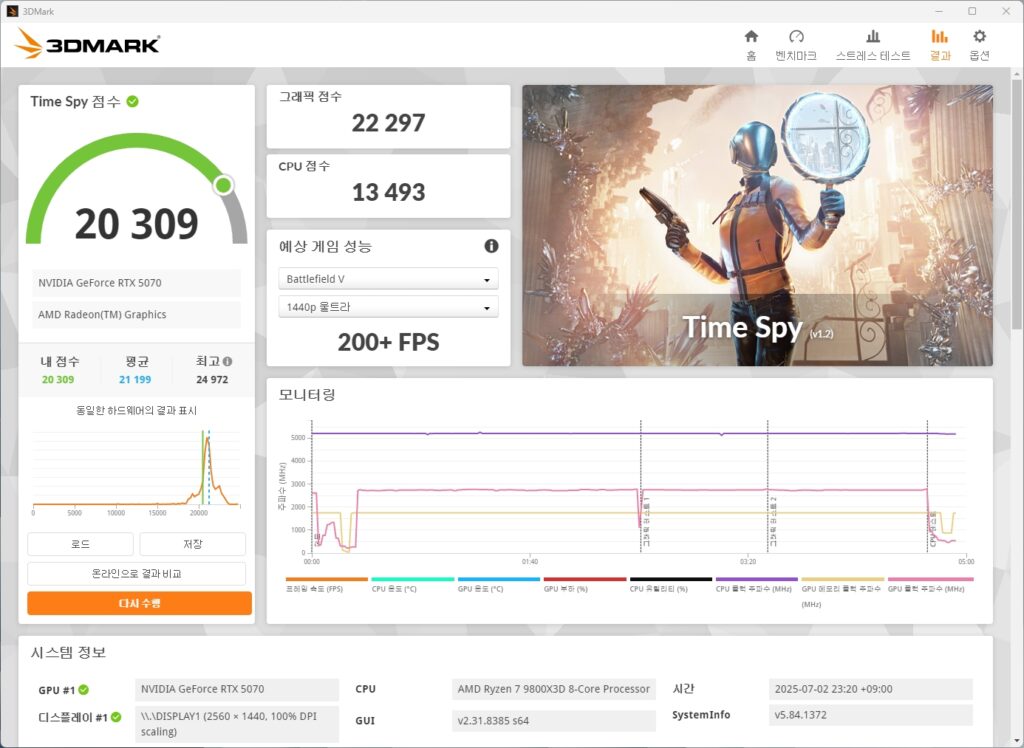
3DMark Steel Nomad simulates the latest gaming environments based on DirectX 12 Ultimate, and the X870E Hero and 9800X3D combination recorded above-average scores. In Time Spy, it showed stable performance in DirectX 12 environments, particularly drawing out the 9800X3D’s performance well in CPU scores.
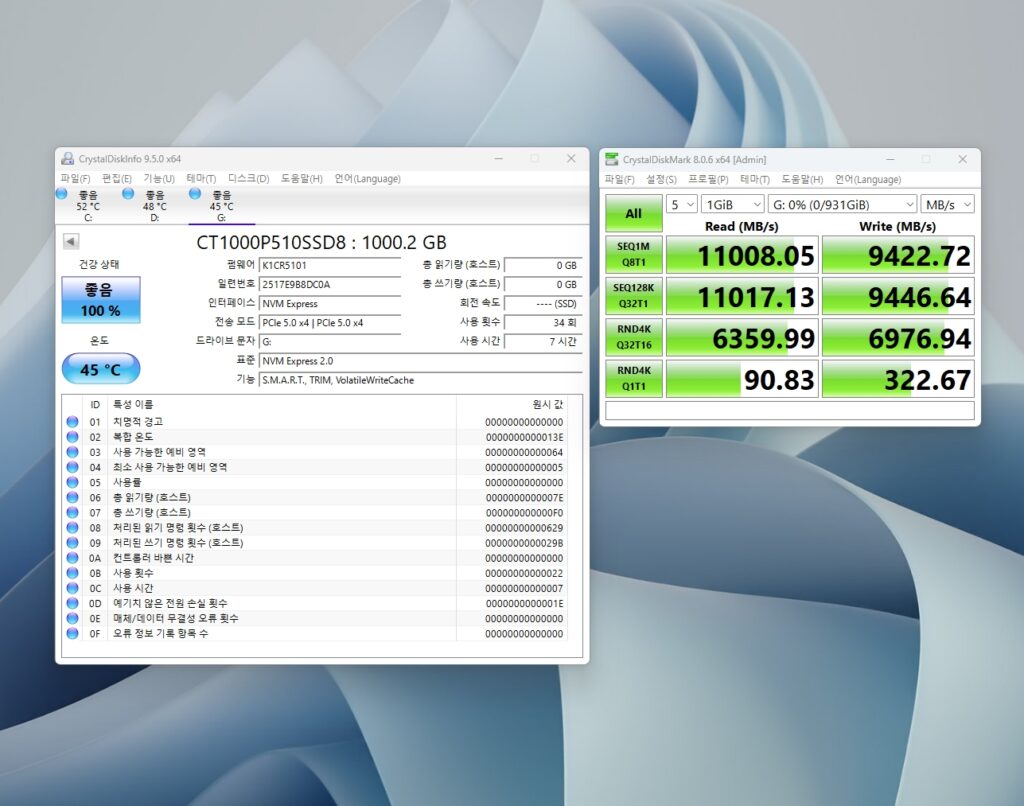
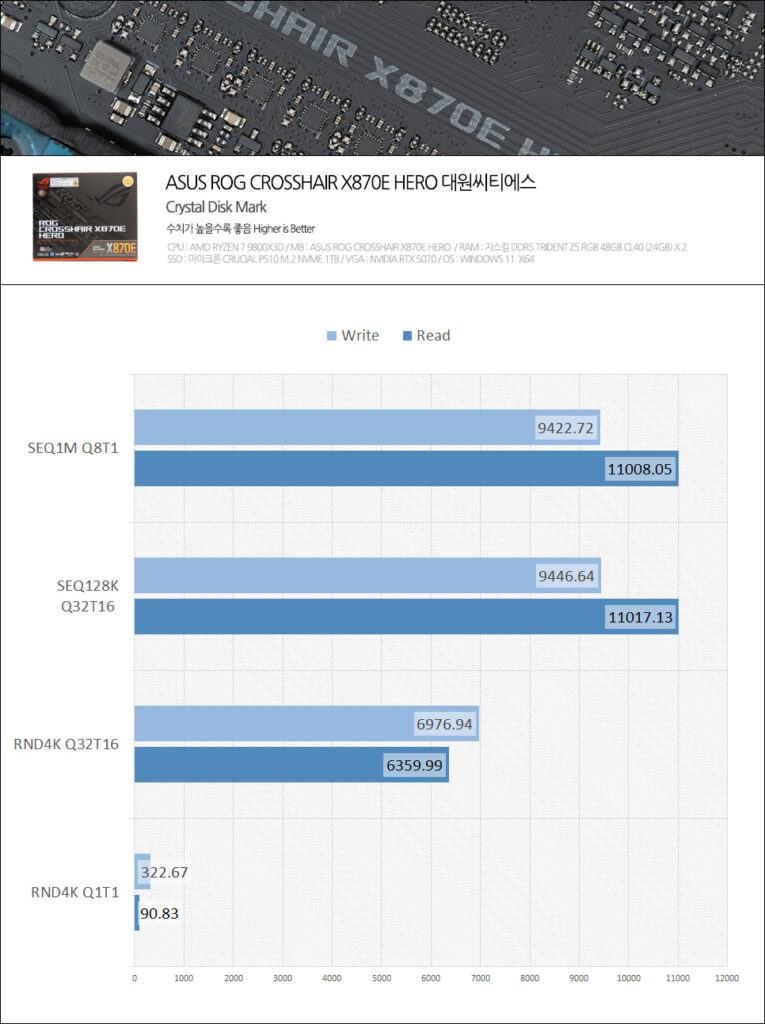
For PCIe 5.0 testing, we measured performance with the Micron P510 SSD, achieving 11,000MB/s in sequential read speeds and 9,422MB/s in sequential write speeds. 4K random speeds improved dramatically, resulting in significant improvements in game loading time reduction and large file processing speeds.
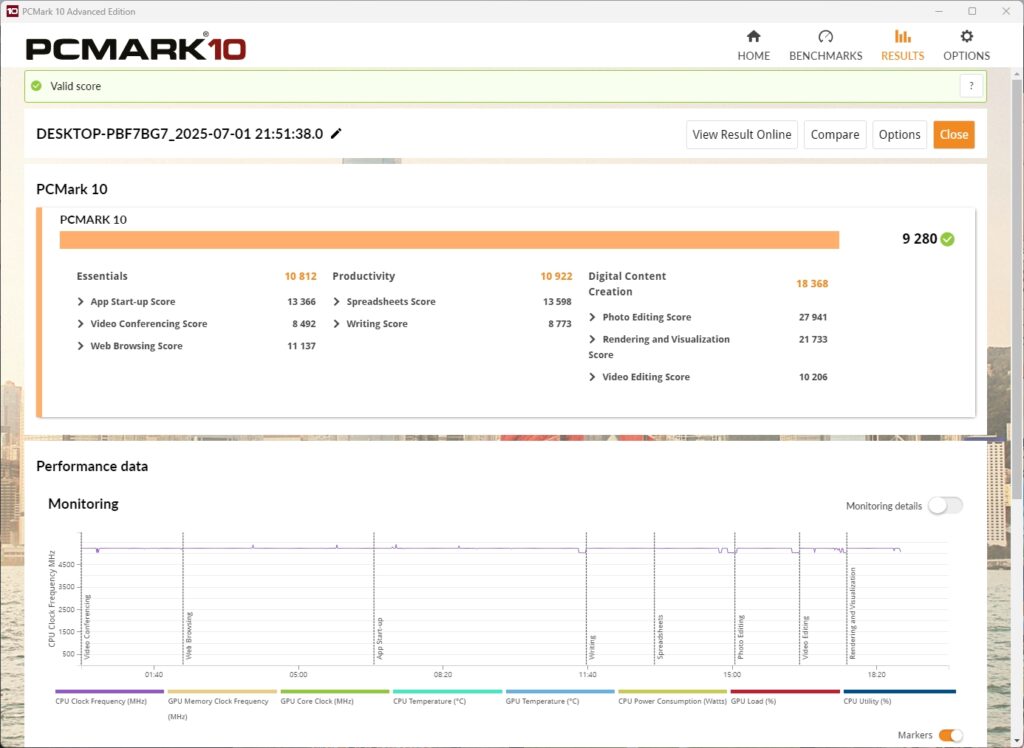
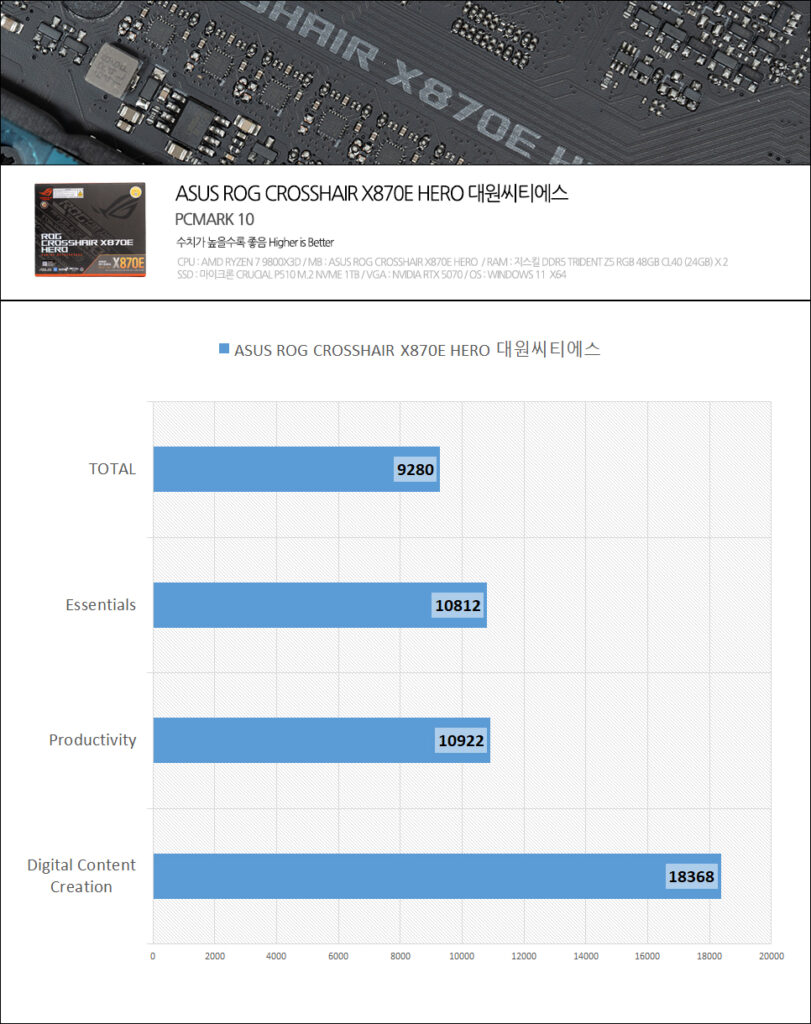
We conducted PCMARK testing to measure actual PC usage performance. This benchmark simulates real-world usage environments, showing excellent responsiveness in office programs and web browsing, and confirming fast processing speeds in video editing and image processing.
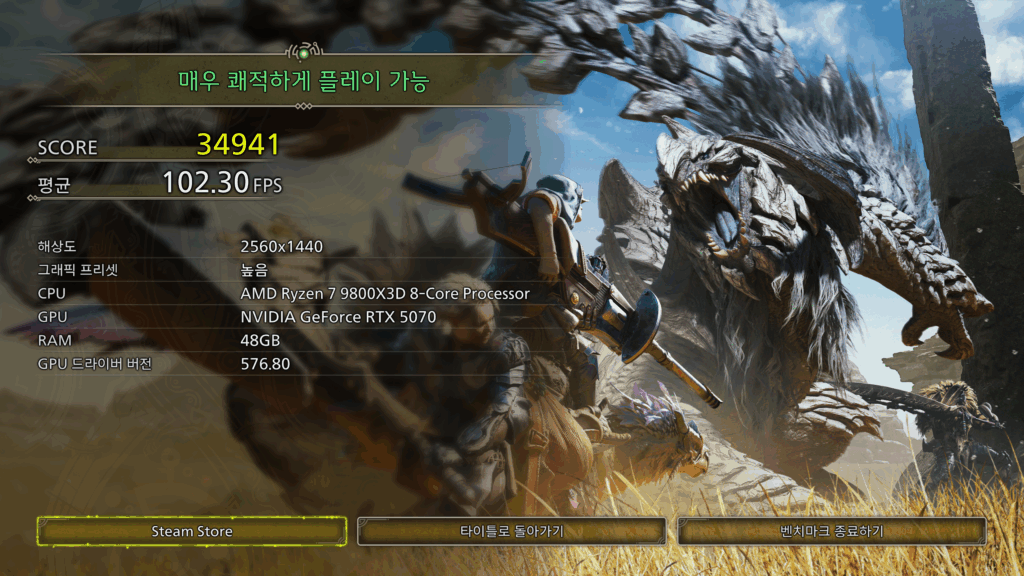
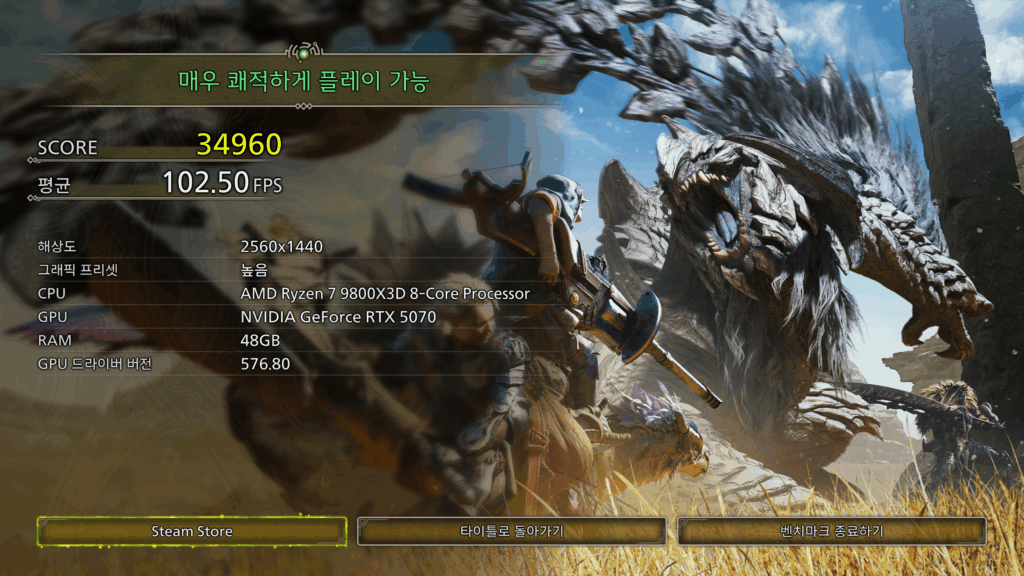
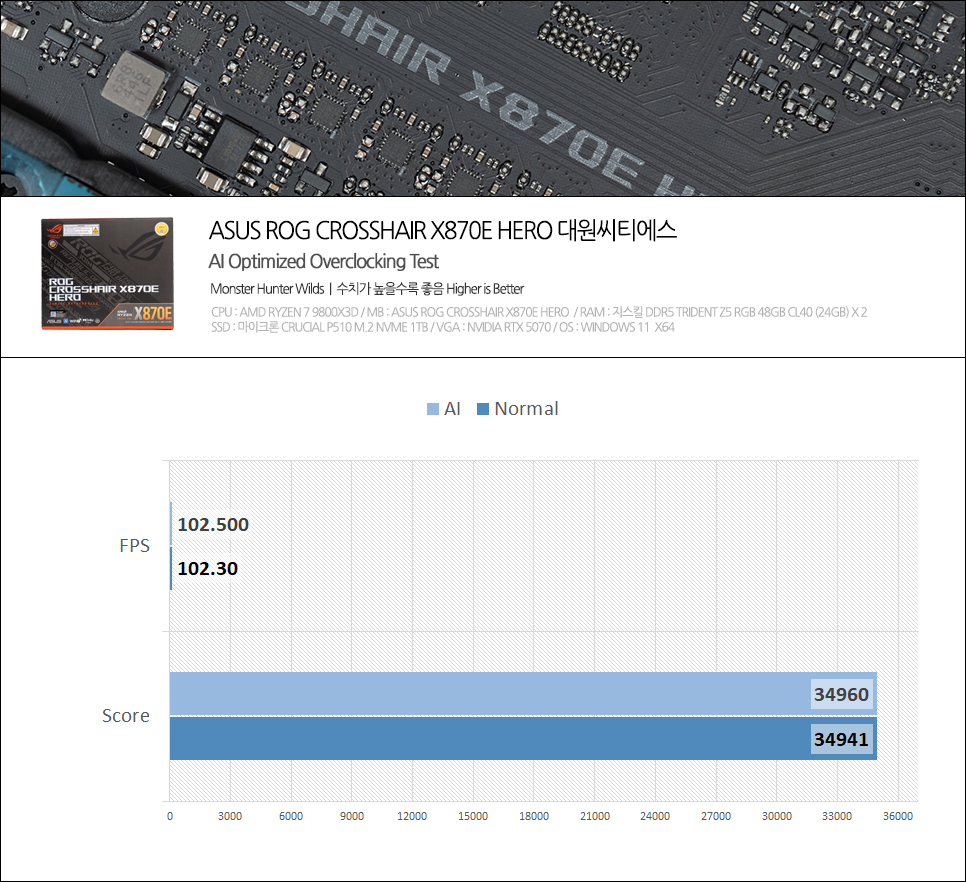
For AI Optimizer testing, we ran Monster Hunter Wilds benchmarking with the function On and Off. A slight performance improvement was observed, but this was within the margin of error. You might be disappointed with this feature since we only tested one game, but we confirmed meaningful performance improvements when testing Intel 285K recently. AMD systems seem to need more testing.
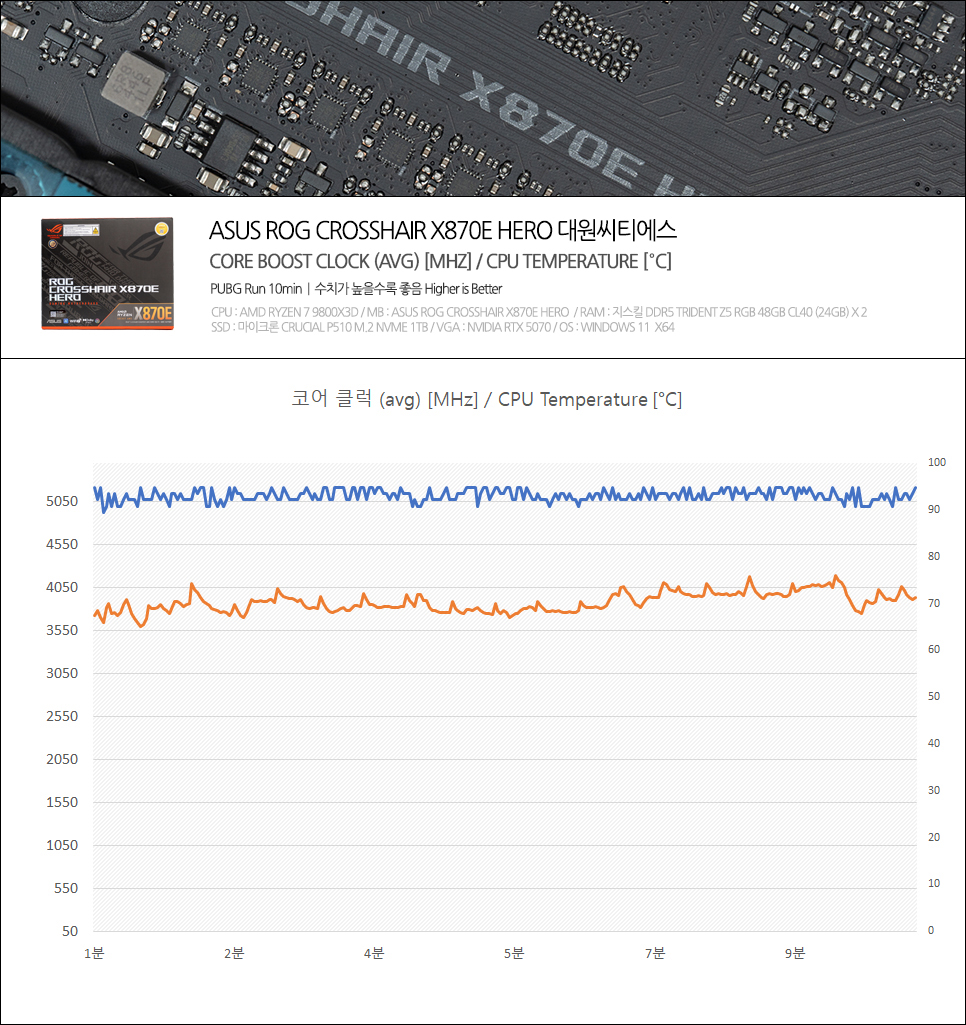
While playing PUBG for 10 minutes and measuring core clock changes and temperature, CPU clocks efficiently operated between 4.7GHz and 5.2GHz according to load. Temperature showed stable thermal management not exceeding 75°C when using a dual-tower air cooler.
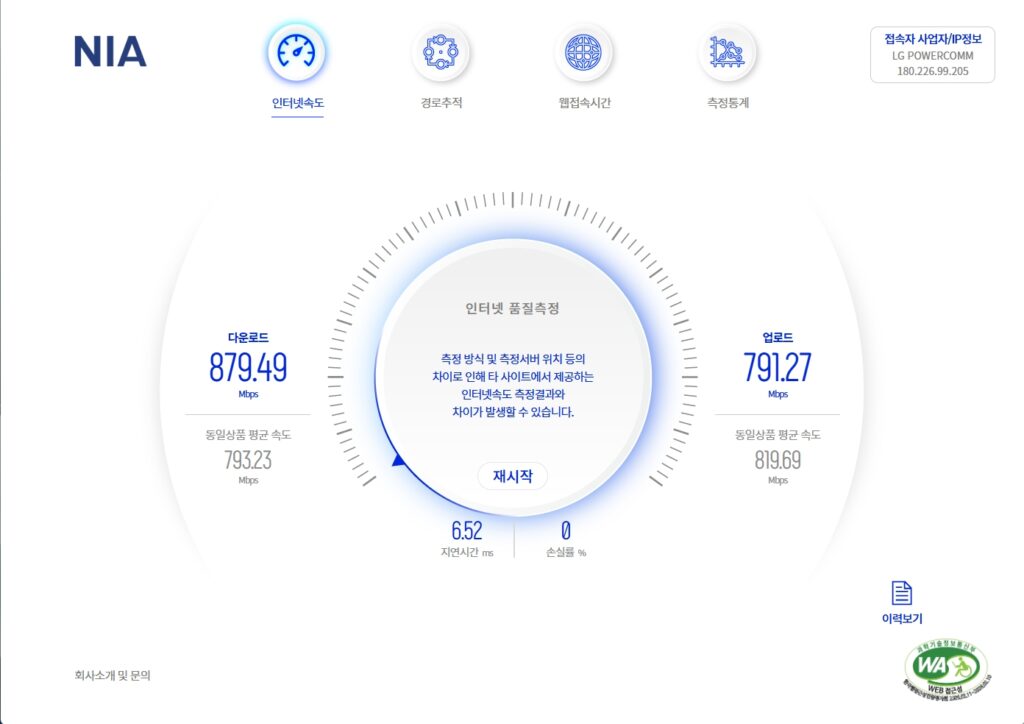
Wi-Fi speed testing was conducted using gigabit internet service. Wi-Fi 7 performance testing showed download speeds of 879Mbps and upload speeds of 791Mbps, delivering nearly identical performance to wired connections. Latency was 6.52ms, showing no significant difference compared to wired connections, confirming that wireless connection alone provides sufficient speed for gaming.
Software
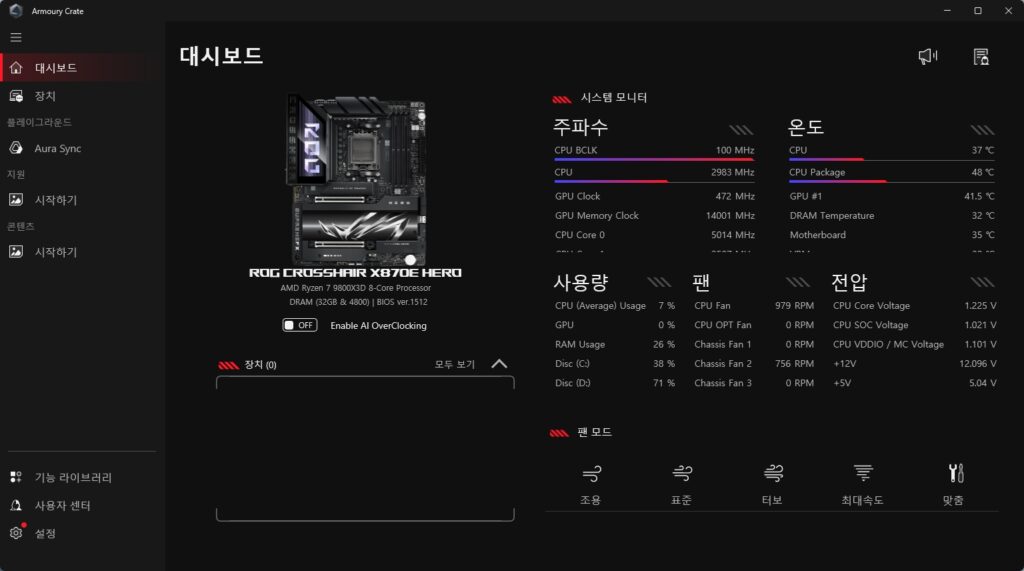
ASUS Armoury Crate is a program that allows integrated management of all ASUS hardware settings in one program. The device menu’s motherboard system monitoring function displays CPU, GPU, and memory usage and temperature in real-time, providing fan speed control with individual curve settings for each fan header.
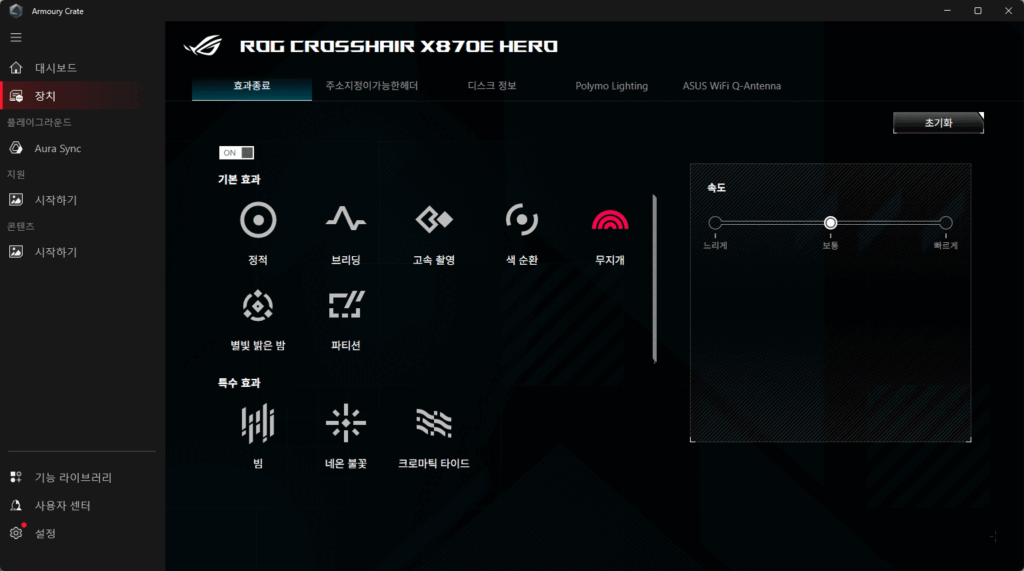
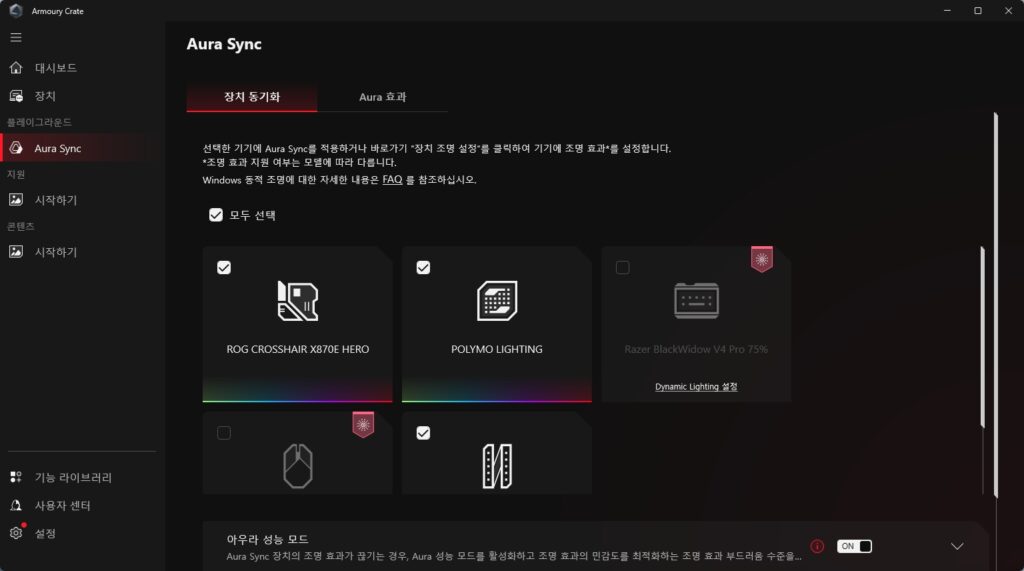
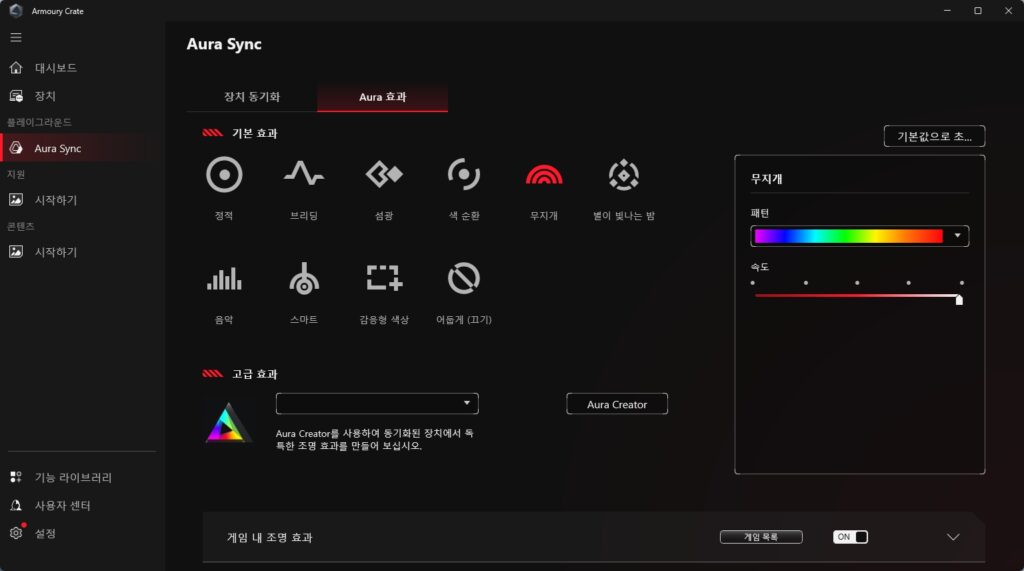
RGB lighting control supports Aura Sync function that synchronizes all ASUS RGB products, dynamic lighting effects based on game situations, lighting pattern changes according to audio signals, and custom functions that can create unlimited color and pattern combinations.
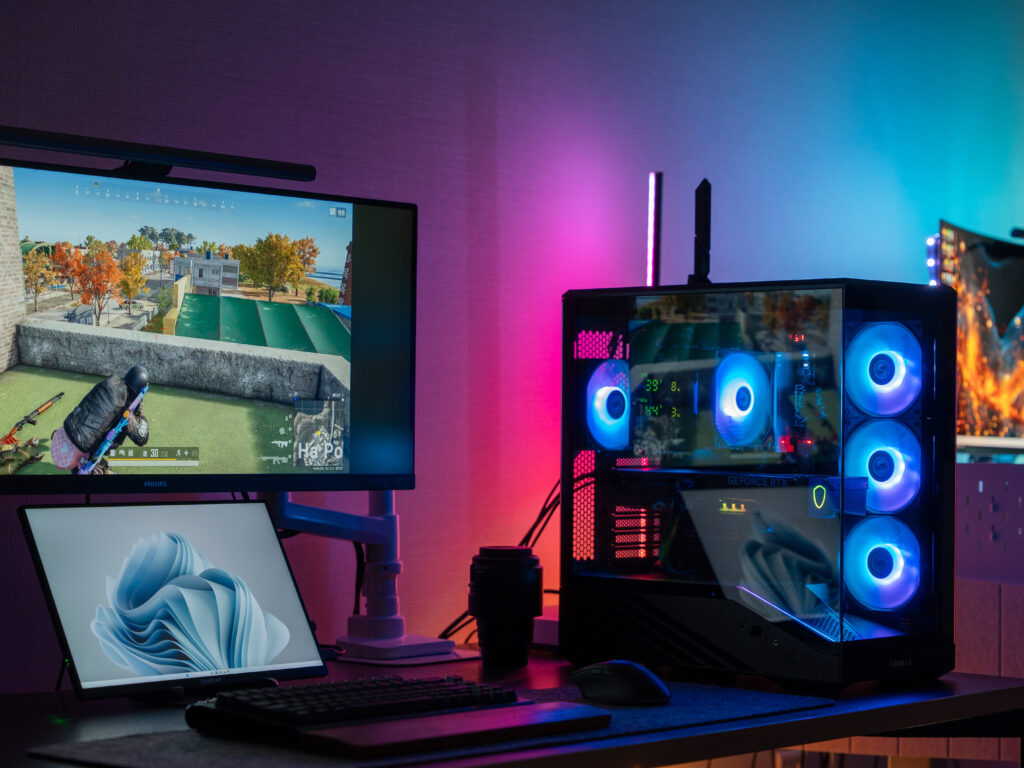
Conclusion
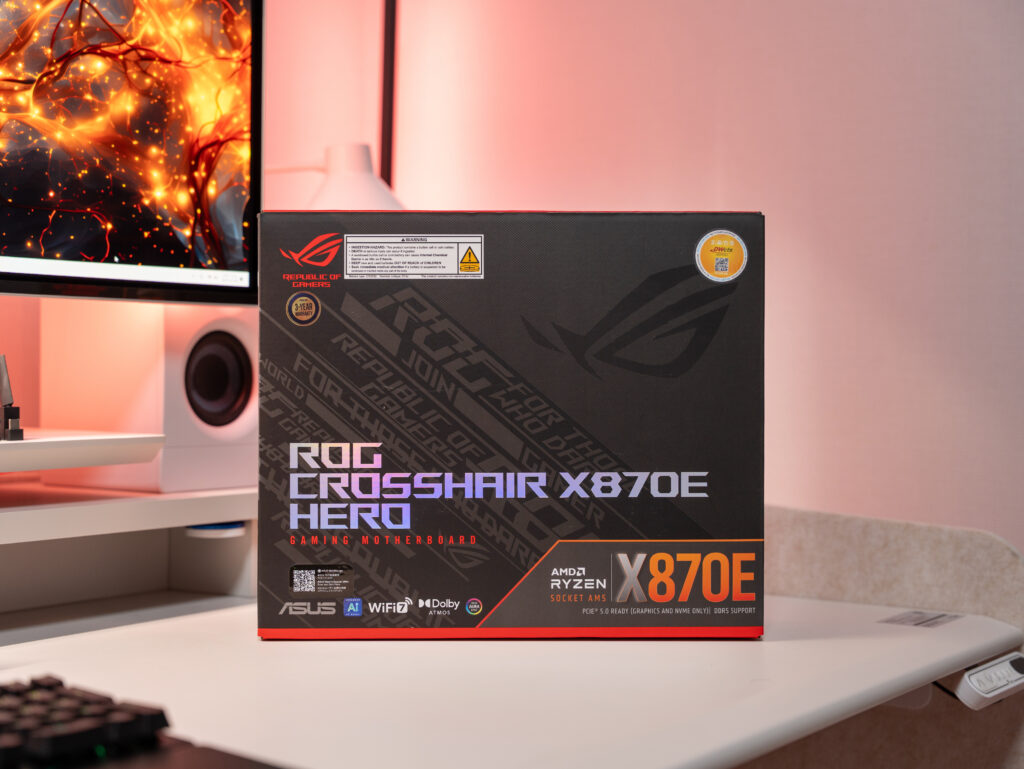
The ASUS ROG CROSSHAIR X870E HERO is a flagship product boasting the highest level of completeness among X870E chipset-based motherboards. The powerful 18+2+2 phase power delivery provides sufficient headroom to stably support not only the 9800X3D but also future high-performance processors. The 1,980A power supply capability and excellent heat dissipation through large heatsinks ensure stable operation even in extreme overclocking environments.
The storage expandability to simultaneously mount three PCIe 5.0 SSDs and two PCIe 4.0 SSDs is convenient for creators doing video/photo editing or building work environments using large amounts of storage. Memory slots with Nitropath technology were confirmed to stably support high-clock DDR5-8000MHz memory.
The ASUS ROG CROSSHAIR X870E HERO has particularly excellent power delivery and expandability among X870E chipset models, making it the best choice for those looking to build flagship gaming PCs. The performance and component configuration that match the high price point, plus stable A/S service from Daewon City distribution, make it a reliable purchase option.
This concludes the AMD 9800X3D motherboard recommendation! ASUS ROG Crosshair X870E HERO performance test.
As an Amazon Associate I earn from qualifying purchases.
Purchase on Amazon : https://amzn.to/4lIUIqx
